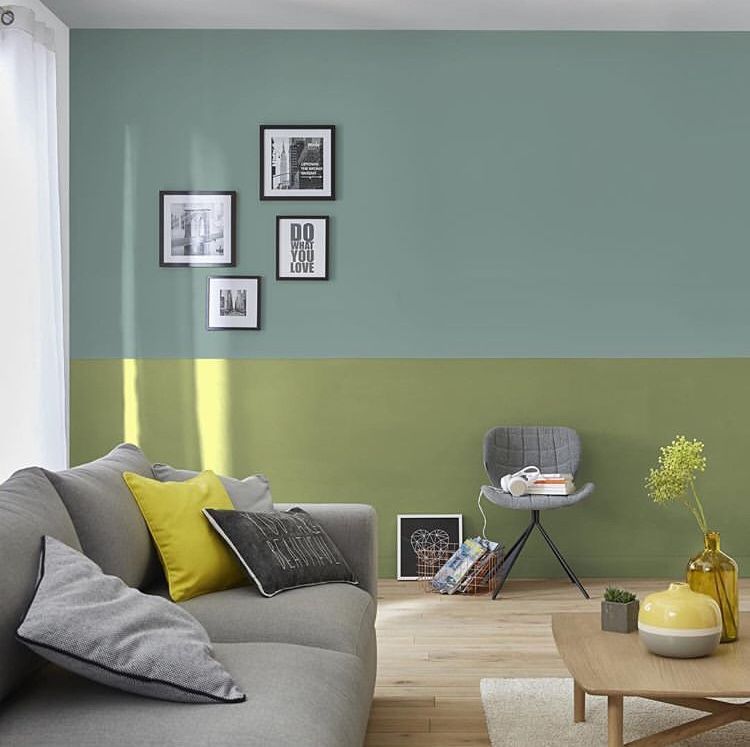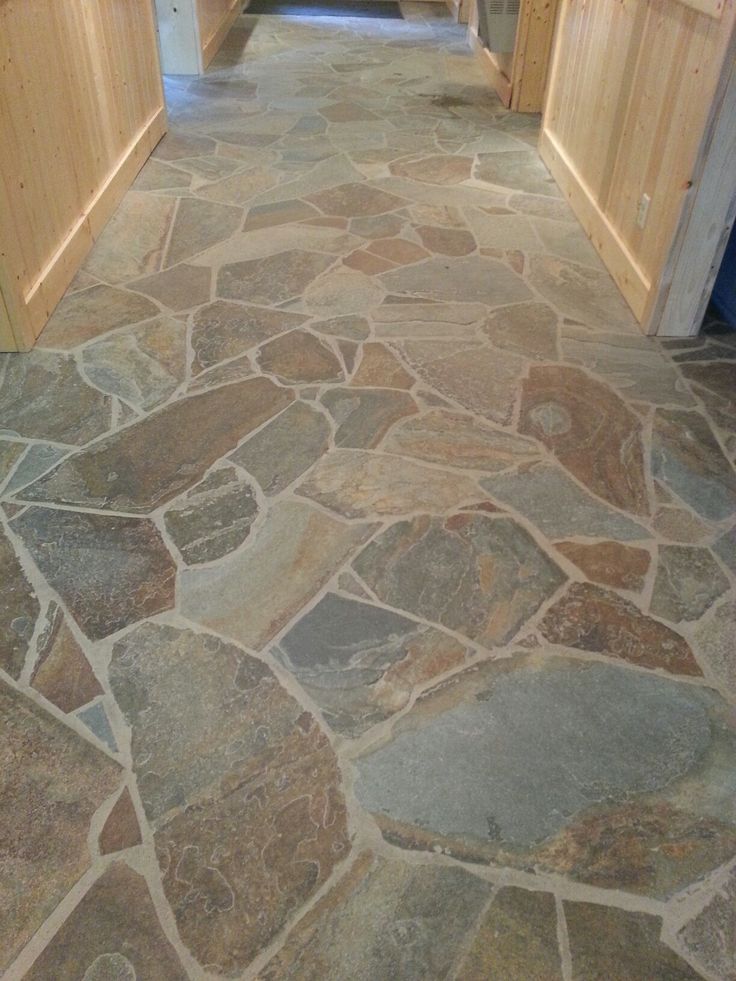Design ideas for wet rooms
16 stunning wet room bathroom designs |
(Image credit: Richstone Properties / Mandarin Stone / l Drummonds / Darren Chung)
Wet room ideas open up the opportunity for contemporary creative design, without the need to squeeze in a shower enclosure or raised shower tray.
A wet room can be a real luxury at home, even when the space you have to work with is limited. Try thinking along the lines of colorful floor-to-ceiling tiles, built-in seating and sleek, concealed pipework.
A true wet room without any panels provides you with more room to move, and an open-layout is easier to keep clean than a regular shower.
However, wet rooms are a big project to take on when it comes to bathroom ideas. The tanking process to ensure your room is completely watertight can be a significant upheaval, not to mention costly, too.
You may want to weigh this up against the longevity of the space, as a wet room’s seamless design makes it a great option for accessibility and future-proofing your home for years to come.
Wet room ideas
Wet rooms have become an increasingly popular choice for shower-lovers because they are the perfect solution for small bathrooms when you don’t have the space for both a bath tub and a separate shower.
The key difference between a shower and a wet room is the fact that while both may have shower screens, wet rooms are completely open spaces without the stand-in tray you will normally get in a shower. The floor is at one level and water is allowed to flow freely to a drain.
A wet room can provide a spacious showering area and the high-end look of a luxurious spa hotel because the look tends to be very streamlined. Wet rooms are also level entry, so easily accessible to all, not to mention hygienic and easy to clean. Done well, a wet room is incredibly desirable and can boost your home’s value, too.
There are a number of things to consider when planning a wet room or walk-in shower – from suitable flooring to drainage points – so that you can achieve the best results.
1. Ensure the space you intend to use is fully tanked
(Image credit: Sarah Hogan)
It goes without saying that a wet room needs to be waterproof. Luckily builders are a lot savvier about how to achieve fully tanked spaces nowadays and wet room tanking systems and products are readily available.
'In particular, hidden tray systems, which fit under the floor tiles and take care of drainage gradients and watertightness have proved a real game-changer,' says Nicholas Cunild, MD of luxury shower brand Matki . 'Low-level shower trays that fit flush with the tiles are also popular and can help define the shower room in a bigger room. Wet room installation is not for novices, it’s important to find a tanking specialist or builder with verifiable experience.'
2. Consider underfloor heating to keep the space dry
(Image credit: Mandarin Stone)
'It’s important to take extra steps with regards to heat, ventilation and drying than you would in a regular bathroom,' continues Nicholas Cunild.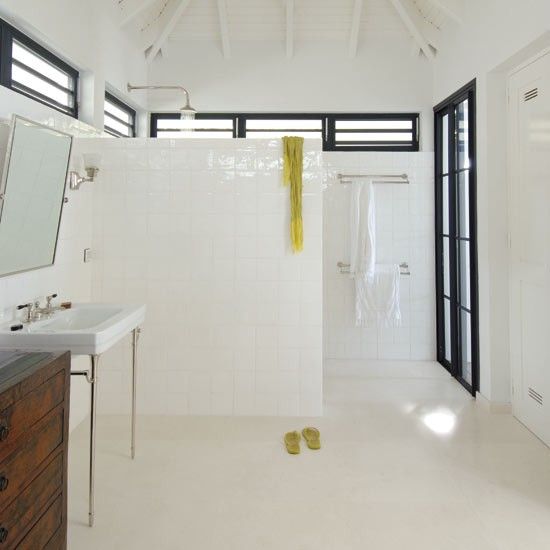 'You may be lucky enough to live in a hot climate which naturally gives a warmer bathroom. But if you live in a colder climate and you exit a wet room onto carpeted rooms – add kids, dogs and all the rest – it is a recipe for waterlogged, messy floors everywhere.
'You may be lucky enough to live in a hot climate which naturally gives a warmer bathroom. But if you live in a colder climate and you exit a wet room onto carpeted rooms – add kids, dogs and all the rest – it is a recipe for waterlogged, messy floors everywhere.
'A screen will help contain major puddles, but underfloor heating and heated towel rails will also speed up the drying process and help prevent slip hazards. Mechanical ventilation is a must and will help clear steam quickly – look for models with intelligent humidity sensors that automatically boost when required.' You can also pair this with a beautiful, easy-to-wash bathroom rug idea.
3. Consider different surfaces ideas, not just tiles
(Image credit: Base Interior)
Tiling from floor-to-ceiling is practical but can feel cold and uninviting in large volumes. Nicholas points out the importance of exploiting other options.
'We’ve noted a rise in polished plaster – both traditional Tadelakt and more modern Microcement – in wet room designs and the results are stunning,' he says.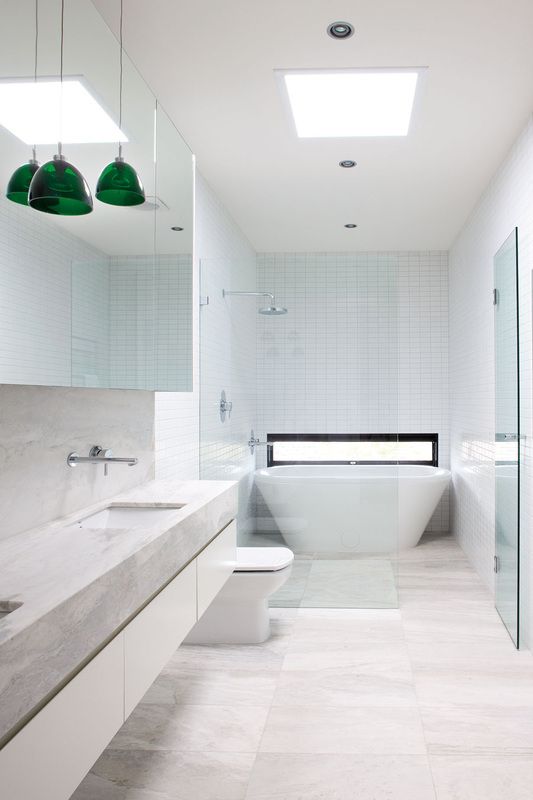
Built up in layers, the finish is waterproof and seamless, so there’s no grubby grout to tackle.
4. Pick the right sanitaryware
(Image credit: Future / Mark Bolton )
'If you are embracing the full wet room in a large bathroom look and omitting any sort of enclosure or screen, it is fundamental to think about your choice of sanitaryware, as it is likely that it will get wet from the spray of the shower or the condensation in the room,' advises Rebecca Milnes, designer at CP Hart .
'Opt for ceramics that are flush to the wall and are ideally wall-mounted. A wall-hung toilet is a brilliant choice in a wet room, as there are no areas for water to pool and it makes cleaning easier.'
Though a bathroom that has been tanked doesn’t necessarily need a shower panel, you may want to add one to prevent towels or toilet rolls getting wet. Opt for a fluted or frosted finish to maintain a level of privacy if your wet room forms part of the main bathroom.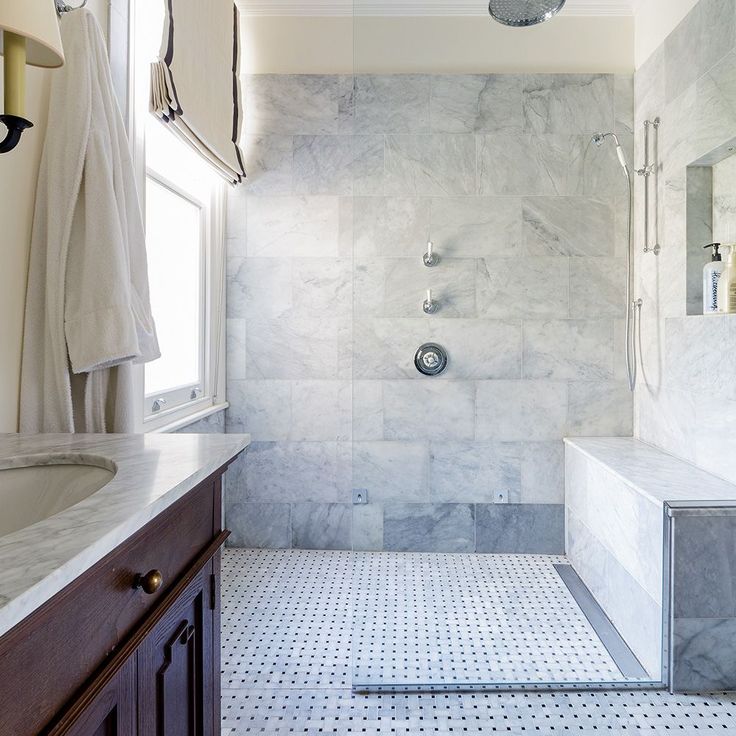
'In order to create a true wet room, a watertight environment must be created by tanking both the floor and walls of the room to thoroughly protect it from leaks. First a watertight membrane is laid, then the room will need to be tiled throughout with a gentle gradient in the main a shower area so the water flows away easily into the waste.'
5. Choose the right size sanitaryware to enhance the sense of space
(Image credit: Matki)
It’s important to choose sanitaryware that is slightly smaller than the average in size so that it can make the room look bigger. A wall-hung toilet with a concealed cistern, is not just easier to keep clean, but being able to see the floor gives the illusion of a bigger room. Wall-hung bathroom vanity ideas will also help reduce visual clutter and use the bathroom space more effectively.
6. Play with the illusion of space
(Image credit: Future / Jonathan Gooch)
Using matching tiles or composite panels on both floors and walls is a good idea for wet rooms and small bathrooms as it will accentuate the sense of space.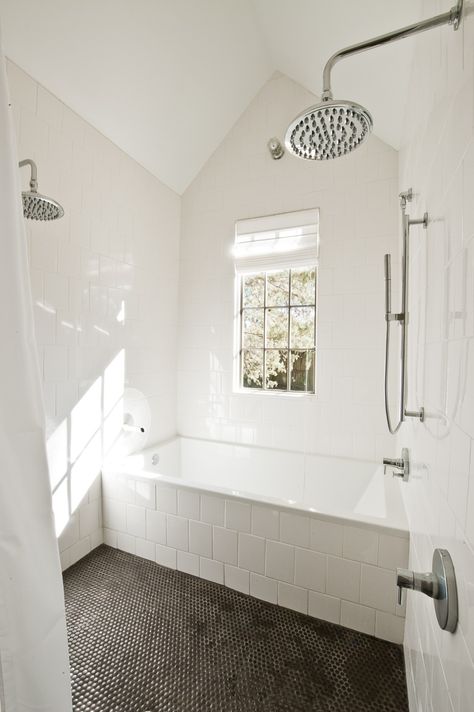
Create areas of bathroom color, and even patterns using mosaics or tiles in a variety of formats, to give definition to your shower space, or mix shapes, sizes and shades for a unique look.
'Add glossy finishes and sleek chrome fittings and use matching shower tile ideas or composite panels on both floors and walls to accentuate the sense of space. Create areas of color and even patterns using mosaics or tiles in a variety of formats to give definition to your shower space, or mix shapes, sizes and shades for a unique look.'
Make sure the floor tiles you want have an appropriate non-slip bathroom flooring rating for wet areas – look out for raised, textured finishes or anti-slip properties in your search.
'Good-quality porcelain tiles are perfect for use in wet rooms and walk-in showers,' says Jo Oliver, Director at Stone & Ceramic Warehouse . 'Firstly, they are impervious to water, making them an ideal solution for everyday use. They also won’t be damaged by detergents or any of the other chemicals we frequently expose our shower surfaces to.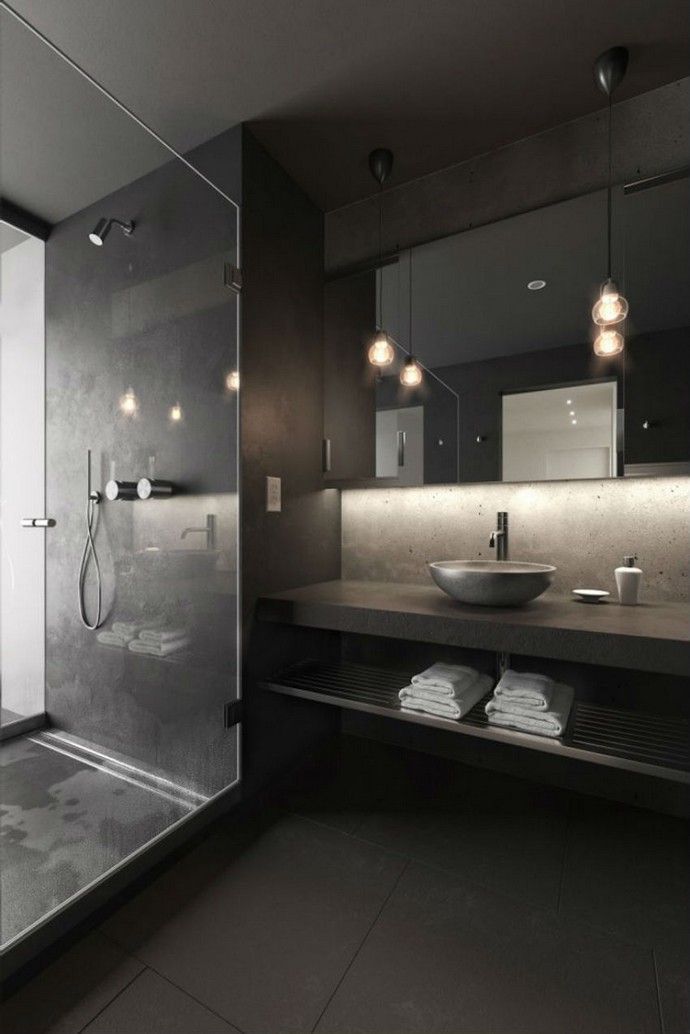 '
'
(Image credit: Max Kim Bee)
While it’s easiest to install a small wet room in a new-build or extension, any bathroom, upstairs or down, can be fully tanked for wet room use.
There are certain situations where a wet room comes into its own. 'Wet rooms are particularly effective in small or awkward scenarios, like rooms with sloped ceilings or strange layouts, as you can maximize the showering area without the restrictions of standard shower tray sizes,' says Nicholas Cunild.
Issues like the direction of floor joists can be problematic but not insurmountable. 'In some cases, you may need to accept a step up into the room, in order to achieve the necessary gradients for efficient water drainage. If it’s done by a good professional, it will be unnoticeable.'
8. Fake a wet room
(Image credit: Future / Darren Chung)
If you are not able to create a true wet room, the latest ultra-low profile shower trays are a clever alternative.
A frameless shower enclosure will give any bathroom a modern, seamless feel and create a contained area for showering without the need for a separate cubicle.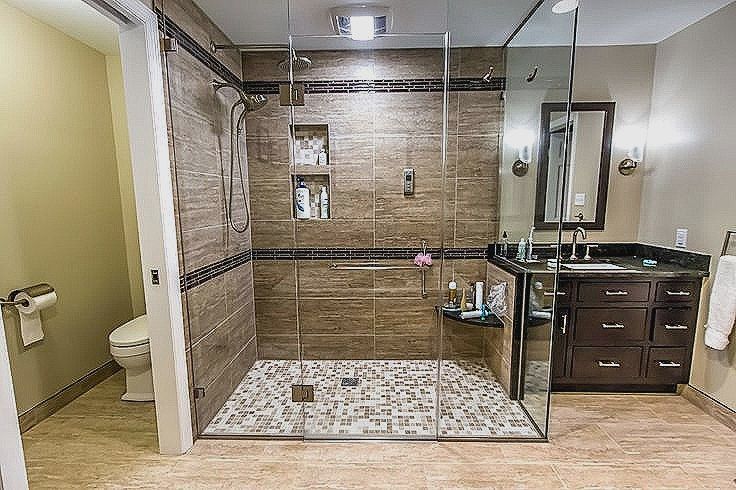
Paired with a low-profile shower tray, these walk-in shower ideas with frameless, clear glass panels help to make even the smallest of spaces feel less claustrophobic and therefore a more calming showering experience.
Don’t forget to allow for adequate drainage at the planning stage. Your shower floor ideas may need to be fitted at a sloped angle away from any doors so water can drain away easily. A sunken shower tray that can be installed flush to the rest of the floor.
9. Bring in pattern to help zone the shower area
(Image credit: Bert & May/ Fired Earth)
Many wet room designs lean towards a minimalist look but it can also be a great opportunity to introduce color and pattern into the space.
Even in an open plan space you can use a showstopping tile on the shower walls and floor to zone the shower area. If you are feeling even braver you can contrast the tiles you use on the floor and walls for even more impact.
10. Find the right tile
(Image credit: Future / Artisan of Devizes)
Bright and colorful wet rooms make for an invigorating shower experience.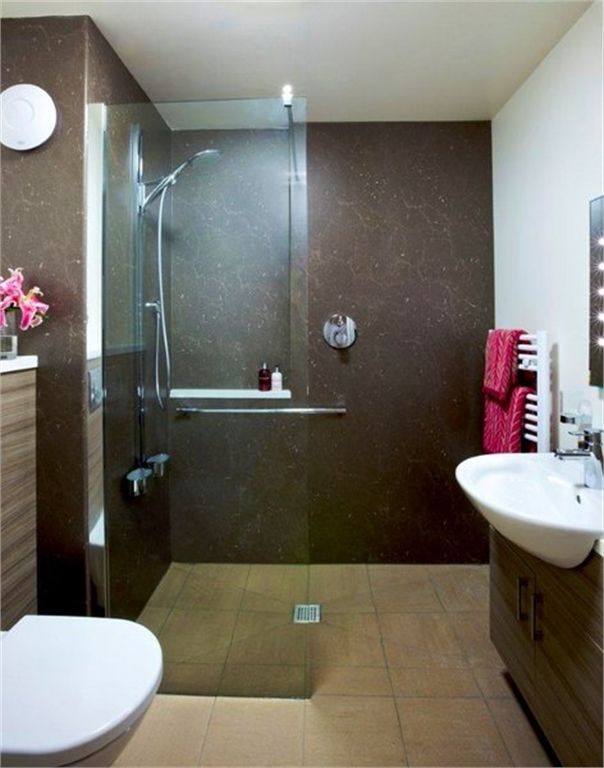 Ideal if you're not naturally a morning person. Smaller bathroom tile ideas like mosaics are a great choice for wet rooms, as they’re easy to lay in a slope towards the drainage hole.
Ideal if you're not naturally a morning person. Smaller bathroom tile ideas like mosaics are a great choice for wet rooms, as they’re easy to lay in a slope towards the drainage hole.
Alternatively, a mix of metro and patterned tiles create a cool and contemporary appearance.
Maintain a seamless look by incorporating a recessed shelf within the shower – a great shower storage idea to keep essential bottles without encroaching on the rest of the space.
11. Enhance the floor factor
(Image credit: Future / Jonathan Gooch)
Shower floor ideas are one of the most important factors when planning and developing a wet room.
Most bathroom flooring types can accommodate the pipes needed for drainage in a wet room – even concrete. But in some instances, the flooring will need to be taken up before tiling takes place to ensure the drainage pipes can be positioned with the necessary slope for the water to drain away.
Tiles are the best type of flooring for a wet room. Damla Turgut, founder of Otto Tiles & Design , advises: 'The most suitable types of tiles for a wet room floor are porcelain or natural stone such as marble, terrazzo, encaustic cement or mosaic tiles. Because of their construction and high-shine finish, we would not recommend the use of ceramic tiles on a wet room floor, they are however suitable for wet room walls as are the very on-trend zellige tiles.'
Damla Turgut, founder of Otto Tiles & Design , advises: 'The most suitable types of tiles for a wet room floor are porcelain or natural stone such as marble, terrazzo, encaustic cement or mosaic tiles. Because of their construction and high-shine finish, we would not recommend the use of ceramic tiles on a wet room floor, they are however suitable for wet room walls as are the very on-trend zellige tiles.'
12. Turn a loft space into a wet room
(Image credit: Future / Davide Lovatti)
There are so many advantage to having a wet room.
You can create a more impressive shower room design in an average-sized bathroom simply by removing the bath and freeing up the space needed for a walk-in shower. For instance, if you have a loft space, consider installing a wet room here.
You probably will need a special extractor fan in your wet room. The build-up of moisture and condensation is greater in a wet room than in a traditional bathroom. Fans operated by light switches alone often aren’t effective enough.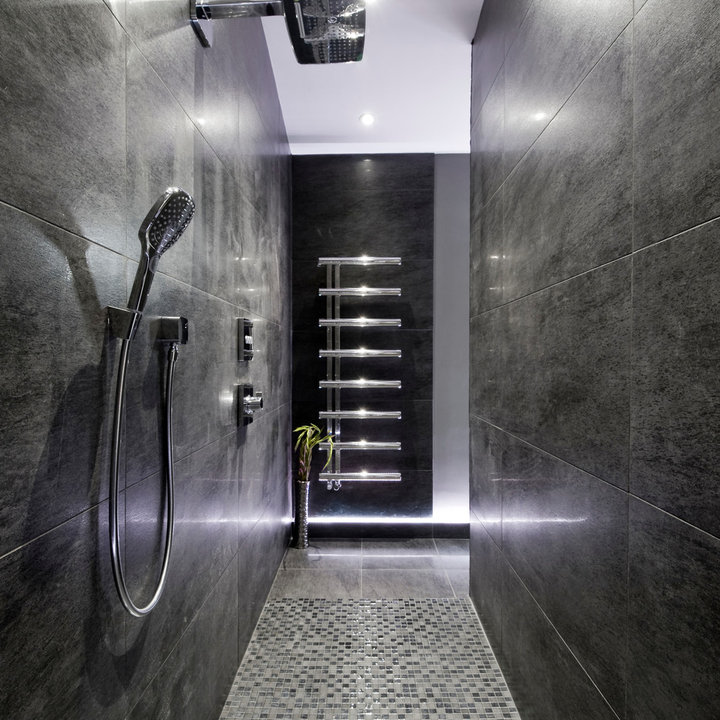 A good fan needs to be wired into the room (still coming on with the light switch) but with a separate cut-off switch, which is outside the room. Humidity-tracking extractor fans are best for wet rooms as they work continuously and incrementally with automatic extraction for however much steam is in the room.
A good fan needs to be wired into the room (still coming on with the light switch) but with a separate cut-off switch, which is outside the room. Humidity-tracking extractor fans are best for wet rooms as they work continuously and incrementally with automatic extraction for however much steam is in the room.
13. Create a spa-like sanctuary
(Image credit: Future / Mark Luscombe-Whyte)
Real estate agents are quick to point out that a family home without a bath will be less saleable, but there are creative wet room ideas with baths you can explore.
If space allows, the bathroom can be turned into a spa-like sanctuary with a bath, vanity unit and smaller wet room-style cubicle.
'Wet rooms give an added level of luxury, allowing a continuous floor finish making a space feel seamless and bigger,' says Gemma Holsgrove, Associate Director at interior design agency Sims Hilditch . 'With cleverly positioned fittings it can certainly feel well thought through.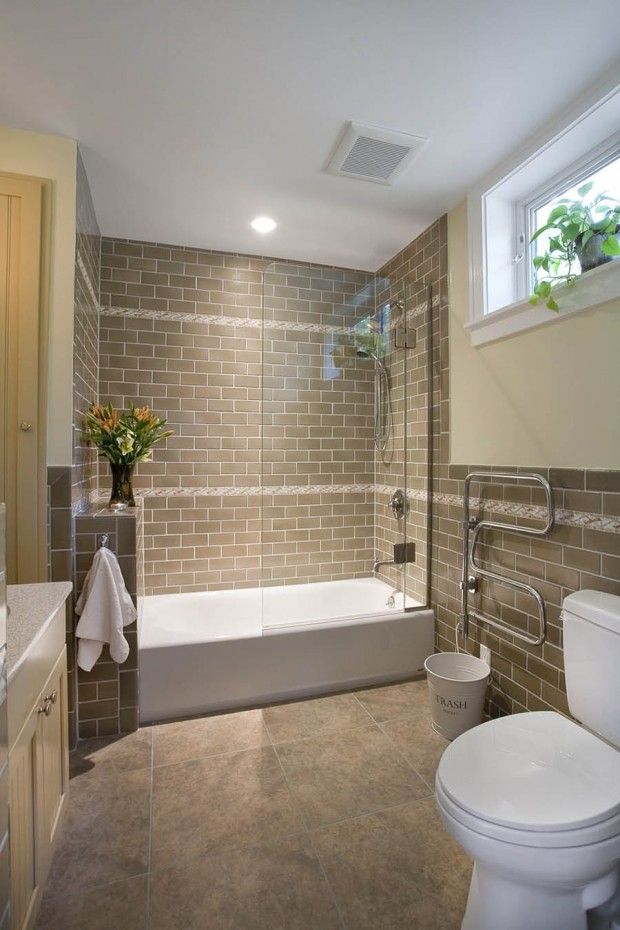 '
'
A wet room design can also work alongside a bath, as Sally Cutchie of BC Designs explains. 'Choosing to have a wet room can actually be hugely beneficial when wanting a bath to sit in the same space,' she says.
'As a wet room is fully waterproof it doesn’t need a shower enclosure fitting,' she adds. 'This can free up a lot of extra space for the all-important bath.'
If your bathroom is on the small side, then use the same material to clad your whole space. A strong stone, like marble, is a stylish option.
14. Take a seat
(Image credit: Fameed Khalique)
Add built-in seating to your wet room for a sauna-like experience. Complete the look with a large rainfall showerhead, then simply sit back and relax.
A wood look can offer a holistic spa bathroom experience, but you'll need to ensure any timber is treated so that it's suitable for a wet area. Or you can mimic the look with tiles. Just make sure they have a non-slip treatment and are comfortable to sit on.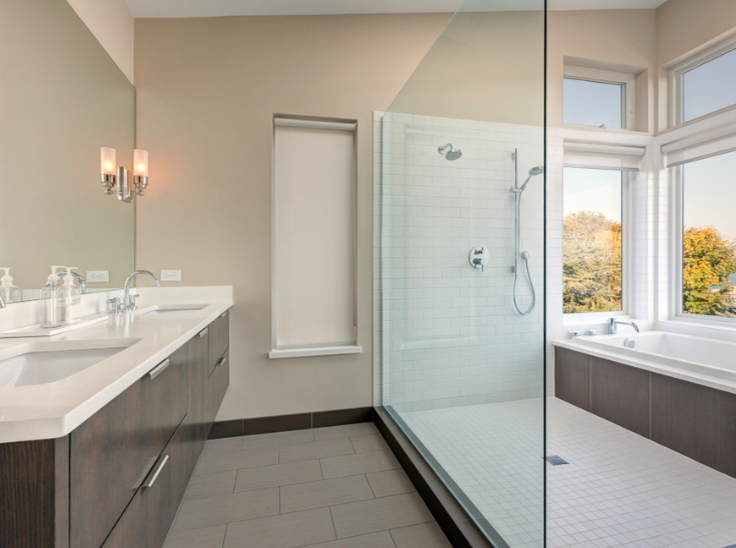
15. Let the light in
(Image credit: Future / Jonathan Gooch)
If you are creating a new space for your wet room, you will need to think about light sources during planning. A huge skylight like this creates the illusion of showering outdoors. So if you've been inspired by trips to tropical climes such as Bali or Thailand, this could be a practical way to recreate that magic.
The best bathroom lighting ideas feature at least two lighting circuits – one for overhead lighting and another for adjustable mood and task lighting. Where you place these will depend on any natural light sources, too.
16. Install a space to rest and recharge
(Image credit: Future / Mark Bolton)
When considering how to choose a shower for your wet room, Paul Bailey, Senior Category Manager at GROHE , says: 'Features such as steam, sound and chromotherapy through built-in lighting modules are increasing in popularity, due to growing demand for spa and wellness inspired bathroom spaces. '
'
Wet rooms are considered a practical and luxurious addition to a home. However, they can be costly. Nick Cryer of Berkeley Place says: 'Wet room installations are more specialist, more time consuming and more expensive. All the materials and kit is very readily available, however, we recommend only experts are employed to complete the installation.'
Are wet rooms a good idea?
There are lots of benefits to having a wet room – from being able to utilise a small or awkward space where a bath or standard shower enclosure cannot fit, to future-proofing your home.
Estate agents are quick to point out that a family home without a bath will be less saleable. But there are creative options you can explore. For instance, if you have a large master bedroom, consider installing a freestanding, statement tub here for a dash of hotel chic.
'Investing time and money into creating a wet room and properly tanking it can also be incredibly useful when it comes to busy family bath times,' says Paul Bailey, Senior Category Manager at GROHE UK.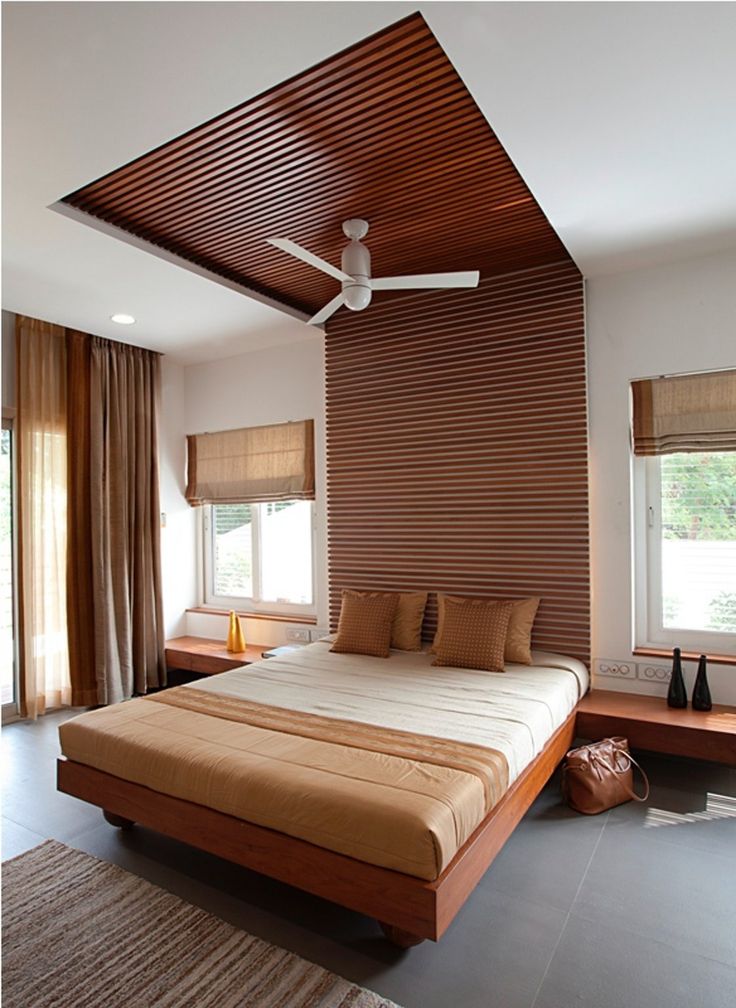
The main drawback is the investment and upheaval a wet room project brings, mainly due to the fact that all wet room ideas require proper tanking.
'One other point worth noting is that wet rooms can get quite cold, because there’s no enclosure to keep the steam in,' adds Yousef Mansuri, head of design at C.P. Hart.
How small can a wet room be?
While wet rooms are not limited to incremental sizing, most bathroom designers would recommend that the showering section of a wet room measures a minimum 800 x 800mm.
When planning a shower design for a small bathroom, there are a few aspects which may determine the space required. Will pipework be exposed or concealed? Do you need to install a glass panel to prevent other areas of the room from getting wet?
Don’t forget that adequate ventilation must also be installed in line with building regulations to prevent mould and damp spots.
Get the right layout for a wet room
There's no denying that plumbing can limit the layout of a wet room.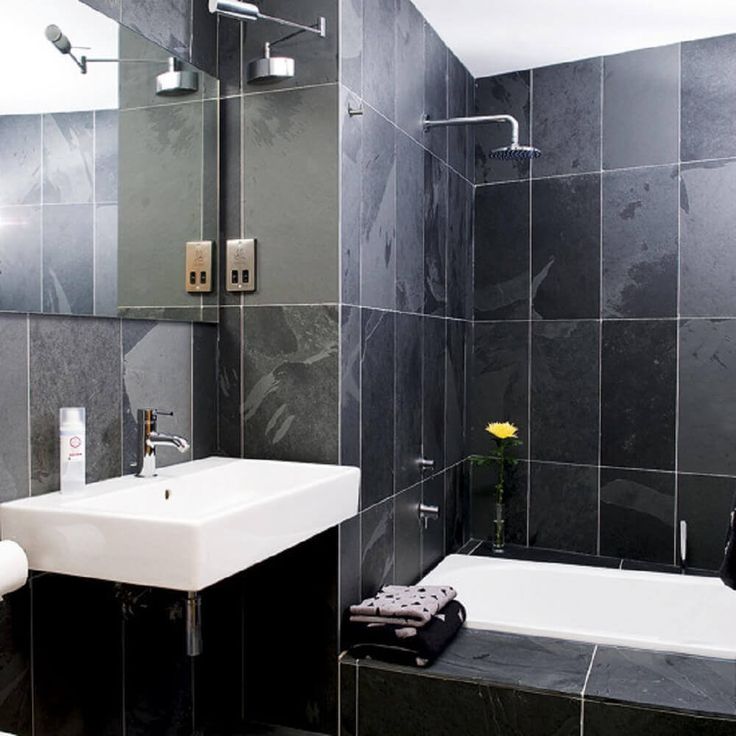 Basins, baths and showers only have to take away water but, if placed 12ft from an outside wall, the drainage will have to slope gently downwards for quite a long way, avoiding joists, which may not be running in a helpful direction. The sooner an architect or plumber raises a few floorboards, the sooner you’ll know your options.
Basins, baths and showers only have to take away water but, if placed 12ft from an outside wall, the drainage will have to slope gently downwards for quite a long way, avoiding joists, which may not be running in a helpful direction. The sooner an architect or plumber raises a few floorboards, the sooner you’ll know your options.
'In a wet room, the shower area is flush with the floor level and the drain is fitted into the fully tiled floor. Originally wet rooms were completely open without any glass partition. However, a simple fixed glass panel creating a walk-in shower area is a much more practical choice and has become the most popular trend,' advises Rebecca Milnes, designer at CP Hart .
'Wet room systems are not limited to incremental sizing, like shower trays often are, so they are a great solution for awkward or tight spaces.
'In small rooms it is possible to turn the whole area into a walk-in shower. However, it is best to be mindful of the items in the bathroom that need to be kept dry, such as towels and toilet rolls.
'One of the first things to consider when planning a wet room is where to position the drain. Ideally the drain should be as far away from the bathroom door as possible, to minimise any risk of water escaping the room.
'If you have a wooden sub-floor, the way your joists run is crucial to where your drain can be positioned. You’ll also need to think about which way the gradient fall towards the waste will run, to avoid any tricky wedging effects.'
What's the difference between a wet room and a walk-in shower?
‘A true wet room is a fully waterproofed space without a fixed shower door or tray, and usually has an open tiled shower area,’ explains Nicholas Cunild, managing director of Matki.
A walk-in shower, on the other hand, is an area in a bathroom or shower room with a low-level shower tray and glass surrounds. While completely watertight, you may still wish to include a glass panel in a wet room to contain the water spray.
Is a wet room expensive?
There’s no doubt that a wet room is an investment.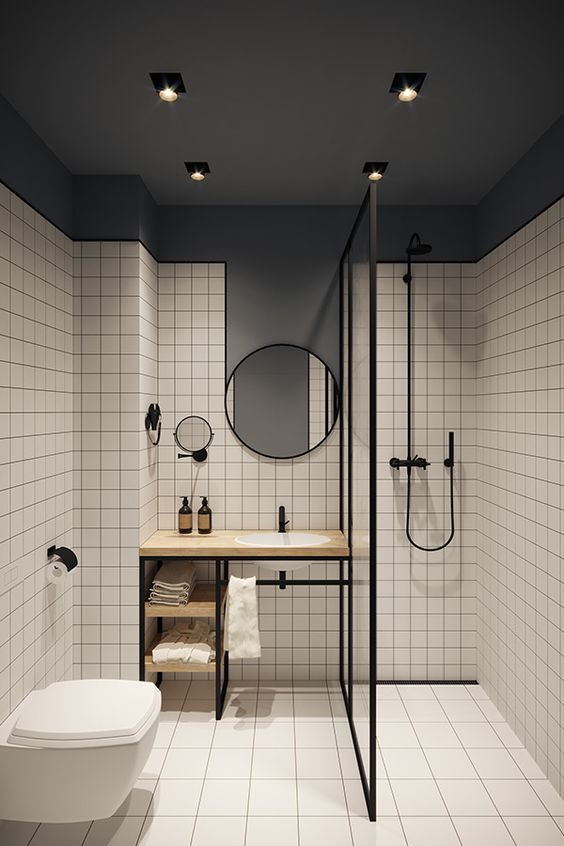 The tanking process to ensure the room is completely waterproof can be costly and takes time. All wet room ideas involve tiling the space from floor to ceiling carefully while ensuring proper drainage.
The tanking process to ensure the room is completely waterproof can be costly and takes time. All wet room ideas involve tiling the space from floor to ceiling carefully while ensuring proper drainage.
Concealing pipework can also be an investment, though this can often allow recessed shelving and storage to be created as an additional benefit.
You can find out how much it costs to install a wet room in our guide.
What kind of costs are involved in a wet room?
It is never cheap to re-do a bathroom. In a family bathroom with two basins, a WC, a bath and a shower, quality items will easily add up to £5,000.
Installation adds a further £3,000 or so and, with cabinets and storage, good quality mirrors, tiles and lighting, it generally adds up to between £10,000 and £15,000.
(Image credit: Future / Davide Lovatti)
The build-up of moisture and condensation is greater in a wet room than in a traditional bathroom. Fans operated by light switches alone often aren’t effective enough.
A good fan needs to be wired into the room (still coming on with the light switch) but with a separate cut-off switch, which is outside the room. Humidity-tracking extractor fans are best for wet rooms as they work continuously and incrementally, with automatic extraction for how much steam is in the room.
Pick the right wet room flooring
'When deciding which wet room system to go for, think about what your sub-floor is made of. There are systems for both solid and wooden floors. If you have a concrete floor, it can be quite invasive to channel in a waste and create the gradient fall required for drainage,' advises Rebecca Milnes of CP Hart.
'Forgoing a shower tray in favour of a wet room allows the floor tiles to run through to the shower area, which adds visual space to a room. However, not all surfaces are safe to use in a wet room setting and it is crucial to know what the slip rating of the material is. I’d recommend using a material with a structured, textured finish to give extra grip in wet areas. Mosaics are also a great choice for wet areas, as the grout lines between the tiles give appropriate grip.
Mosaics are also a great choice for wet areas, as the grout lines between the tiles give appropriate grip.
'In cases where a step-up to the wet area is needed, the step should be at least 10cm high, as anything lower can be easily overlooked by those not familiar with the room and can become a trip hazard. Adding under-plinth lighting can highlight the step and add ambiance to the room.'
Tanking a wet room
'Tanking is essential in a wet room,' says Rebecca Milnes. 'This is a multi-step process which entails several layers of waterproofing to ensure an excellent seal – much like a swimming pool.
'The two main approaches for tanking a wet room are using a self-adhesive bitumen-based waterproof membrane, or applying a paint-on liquid wall membrane. It is always best to speak to your supplier about the best system for your project.'
Jennifer is the Digital Editor at Homes & Gardens. Having worked in the interiors industry for a number of years, spanning many publications, she now hones her digital prowess on the 'best interiors website' in the world.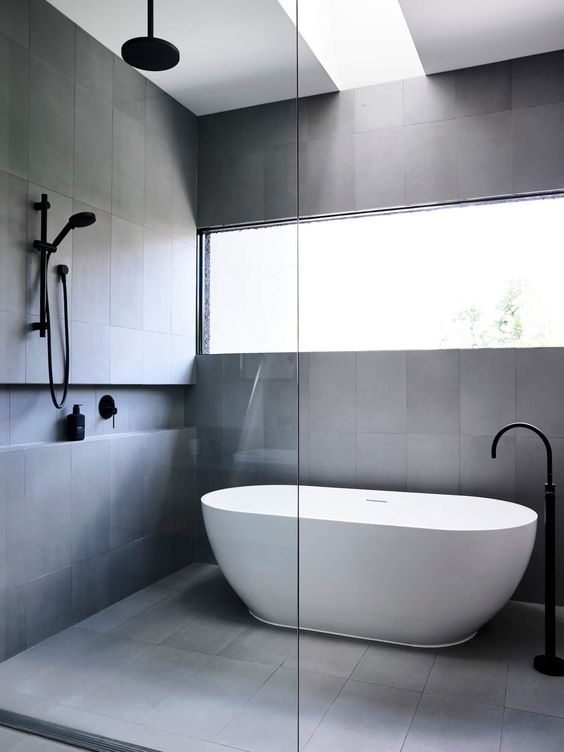 Multi-skilled, Jennifer has worked in PR and marketing, and the occasional dabble in the social media, commercial and e-commerce space. Over the years, she has written about every area of the home, from compiling design houses from some of the best interior designers in the world to sourcing celebrity homes, reviewing appliances and even the odd news story or two.
Multi-skilled, Jennifer has worked in PR and marketing, and the occasional dabble in the social media, commercial and e-commerce space. Over the years, she has written about every area of the home, from compiling design houses from some of the best interior designers in the world to sourcing celebrity homes, reviewing appliances and even the odd news story or two.
13 wet room ideas and tricks for a minimalist bathroom |
(Image credit: Darren Chung)
For many years, wet room ideas were a divisive choice for a bathroom renovation. While they were favored for the idea that they could make your space look bigger, and that they work well for small spaces, the major drawback was the idea that when you shower, the whole bathroom gets wet.
Originally, wet rooms were completely open without any glass partition, however, a simple fixed glass panel creating a walk-in shower area is a much more practical choice and the general trend for wet rooms has evolved to include some sort of shower screen.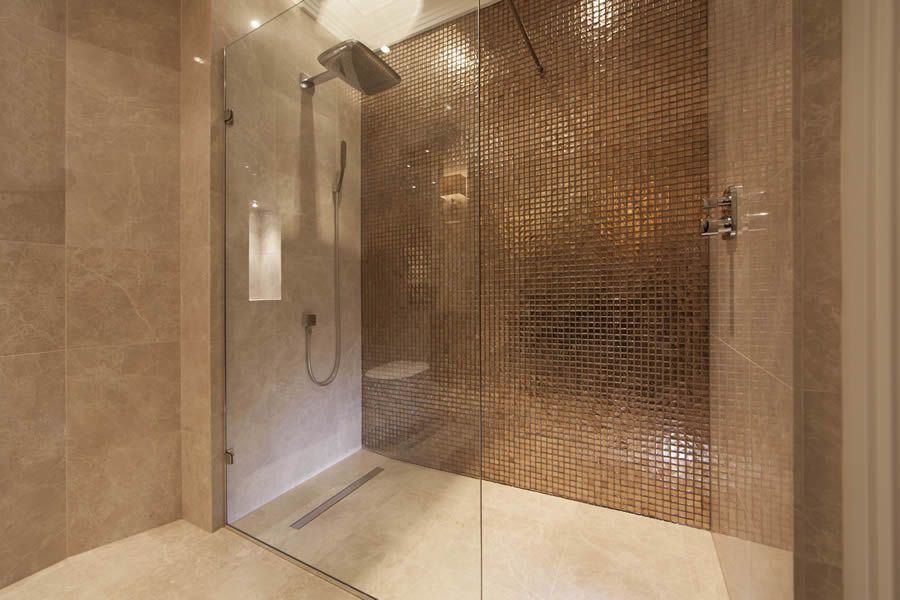
Now, in terms of modern bathroom ideas, wet rooms are certainly up there with the most popular. While the process of installing a wet room might be more disruptive and expensive than a standard bathroom re-fit, by tanking the envelope of your bathroom, you can streamline your floor tile finishes and create level-access showers which are more practical.
All-in-all, this means a more minimalist, modern bathroom, but the design possibilities don't end there. From types of floor and wall finishes to screens and alternative bathroom layouts, take a look at our gallery of the very best in wet room ideas to inspire your space.
Wet room ideas
Wet rooms are ideal as small bathroom ideas or awkward spaces such as below sloping ceilings or in rooms with height restrictions. They’re a job best left to the professionals to ensure adequate drainage, tanking, and slip resistance. If you love the spacious look of a wet room, creating a wet room-style showering area is much easier thanks to the variety of off-the-shelf low-profile shower trays, recessed storage niches, and frameless glass shower screens and hinged doorways now on offer.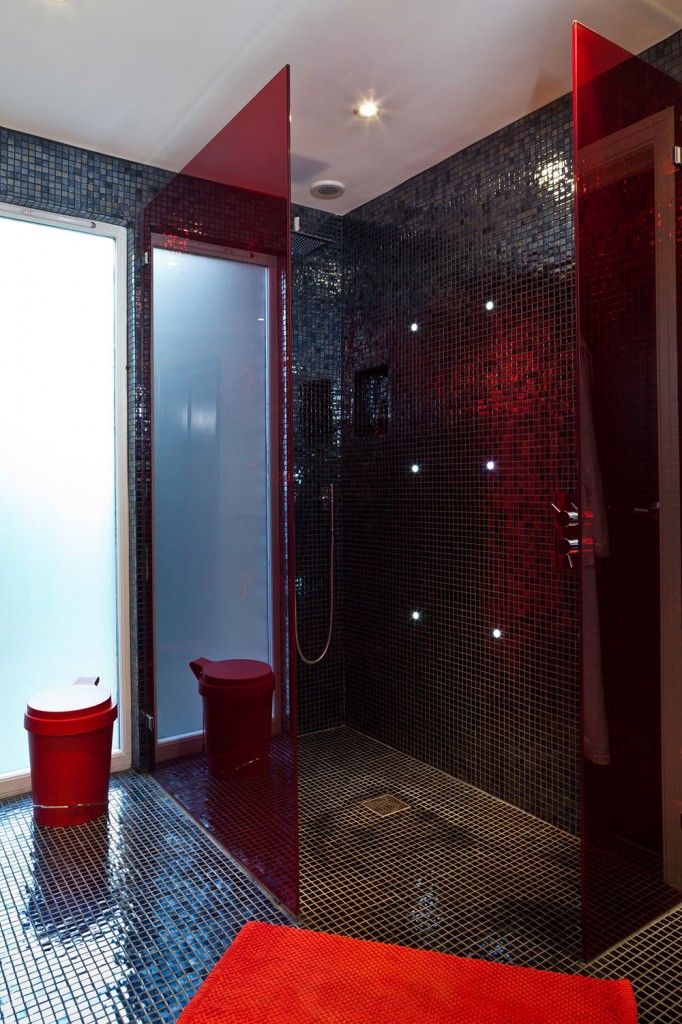
Bespoke trays and screens offer the option of creating a generously sized shower room – perhaps for two – where you can take advantage of the latest shower systems that transform washing into a wellbeing experience, with their wall-mounted body jets and rainfall showerheads incorporating steam, aromatherapy, and chromotherapy features.
(Image credit: Future)
There are some practicalities to consider as part of your wet room design too. One of the first things to consider when planning a wet room is where to position the drain. Ideally, the drain should be as far away from the bathroom door as possible, to minimize any risk of water escaping the room. If you have a wooden sub-floor, the way your joists run is crucial to where your drain can be positioned. A gentle slope or gradient in the main shower area will help ensure that water flows away easily into the waste.
In a wet room, the shower area is flush with the floor level and the drain is fitted into the fully tiled floor.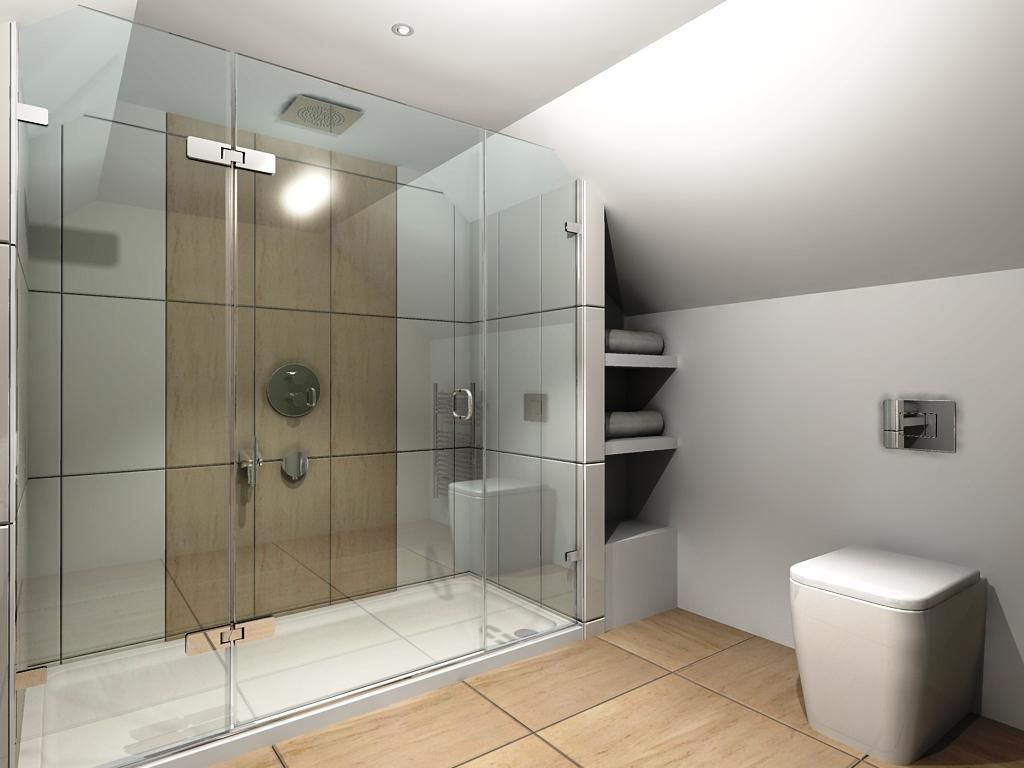
1. Use tadelakt for an on-trend wet room
(Image credit: Darren Chung)
Tadelakt, a traditional Moroccan polished plaster has become a bathroom trend for wet rooms thanks to its good looks and practical nature. 'Homeowners are creating design-led wet rooms without grout lines that can collect dirt and grime,' explains Ian Kozlowski, founder of Decor Tadelakt , 'but it's also an eco-friendly, unique wall covering, offering minimalist beauty and texture.'
Polished with olive soap for a waterproof finish, tadelakt can be used across all the walls in a wet room for a seamless finish, however, it's not really suitable for flooring, and should be combined with tiles or another bathroom flooring idea.
(Image credit: James Merrell)
When it comes to choosing bathroom tile ideas, mosaic tiles have a lot to offer. They are not only easy to apply, and can be worked well around a shower drain without awkward cuts and fussy detailing, but they can also be used to create bold designs like this two-tone stripe wet room, which runs into the shower area.
Mosaic tiles are also great underfoot, with extra grout lines creating a non-slip surface. However, be wary that all this extra grout isn't always a practical choice when it comes to keeping your wet room clean and looking its best.
3. Or choose large format tiles for a practical wet room
(Image credit: Anna Stathaki)
If you ask Roisin Lafferty, creative director of Kingston Lafferty Design , she'll warn you against using excesses of small tiles in wet rooms. 'I am an absolute lover of detailed and intricate tiling, however not for a wet room – where it’s a case of the less grout the better for longevity and cleanliness,' she says.
'Large-format marble is timeless and very practical, just make sure you have a slip rating if required. Large-format terrazzo or tiles give a similar streamlined effect. And for the highest-end finish, opt for a seamless full-height glass screen with minimal framing or fittings.'
When using large format tiles for a walk-in shower, you need to make sure you specify anti-slip tiles on the floor, especially for shower tile flooring ideas where there's the greatest chance of slipping on wet flooring.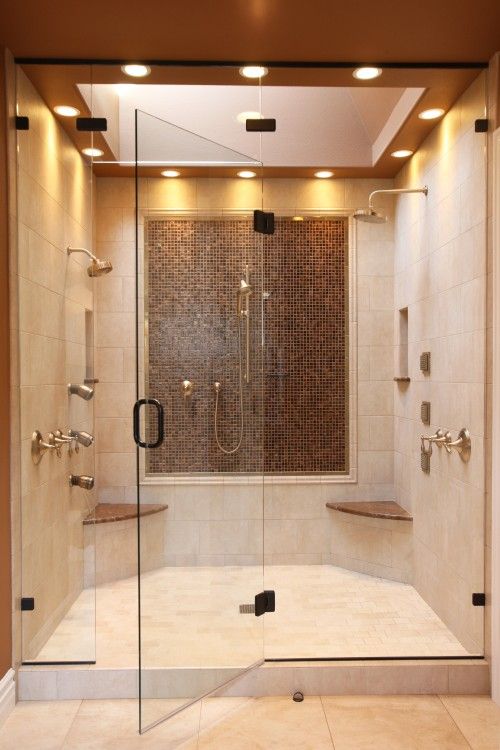
4. Pick a folding shower screen for a small wet room
(Image credit: BC Designs )
Wet rooms have a great advantage in a small bathroom layout in that they don't require bulky shower trays or enclosures, meaning that it's possible to squeeze a shower into a tight corner, often next to a bath.
'When it comes to showers, a separate shower can often be considered a luxury if space is tight. However, there are a couple of clever ways around it including wet rooms and folding shower screens that take up much less room than a typical shower,' says Barrie Cutchie, design director at BC Designs.
In this small bathroom shower idea, a fixed screen would have made access to the shower and the bath difficult and cramped, while the folding shower screen still helps to keep water in one area of the wet room.
(Image credit: Drummonds)
Reeded glass isn't just a huge interior design trend, it's a no-brainer for a beautiful wet room. Not only does the texture of this glass add to a richer scheme, but it can also be used to create pockets of privacy in a wet room, whether it's being used by more than one person at once, or shielding a shower from the view of a window. There are plenty of shower screens on the market featuring reeded glass too, while enclosures using this type of glass are harder to come by.
There are plenty of shower screens on the market featuring reeded glass too, while enclosures using this type of glass are harder to come by.
Reeded glass is also a little more forgiving than standard glass when it comes to watermarks and limescale, making it a practical choice too.
6. Opt for a modern Crittall-style shower screen
(Image credit: Day True)
Just as steel-framed dividers and doors are much-loved elsewhere in our homes, Crittall-style shower screens are a popular choice for bathrooms and wet rooms for a luxe addition to the space.
In this design by Day True , the wet room also positions the shower underneath a large roof light, bathing the space with natural light while retaining its sense of privacy.
7. Or go for a minimalist shower screen
(Image credit: Brian O'Tuama Architects)
While you may be tempted by these feature shower screens, sometimes the best option for a wet room is the simplest. As you have the design possibility to use one tile for flooring throughout a wet room, and with no trays or enclosures to carve up the space, a minimalist shower screen, like this used in this project from Brian O'Tuama Architects , which highlights the seamless nature of the space.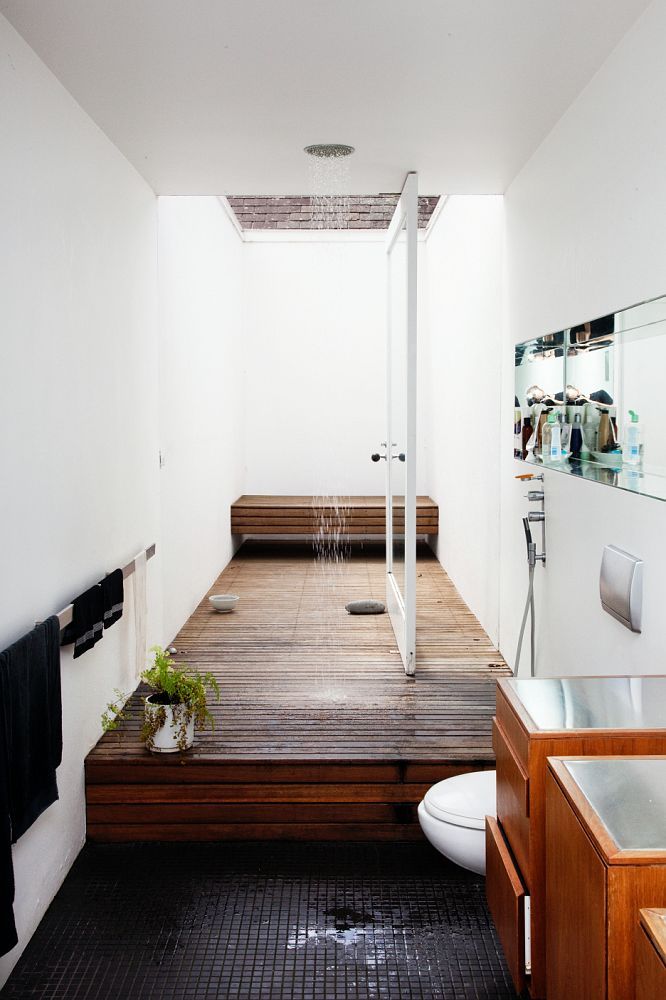
Consider slimline frames and concealed fixings, as seen in this brass and marble bathroom idea, reducing visual noise for a picture-perfect wet room
(Image credit: Mandarin Stone)
The beauty of a wet room is that you don't have to have a screen at all if you don't want to. However, practically when using the space, and for those using it after you, it can help to consider where water will sit in the space. In an ideal world, you'll want water and spray to not reach areas like the basin, where you might want to later stand with dry feet.
'If you are embracing the full wet room look and omitting any sort of enclosure or screen, it is fundamental to think about your choice of sanitaryware, as it is likely that it will get wet from the spray of the shower or the condensation in the room,' says C.P. Hart 's Rebecca Milnes. 'Opt for ceramics that are flush to the wall and are ideally wall-mounted. A wall-hung toilet is a brilliant choice in a wet room, as there are no areas for water to pool and makes cleaning easier.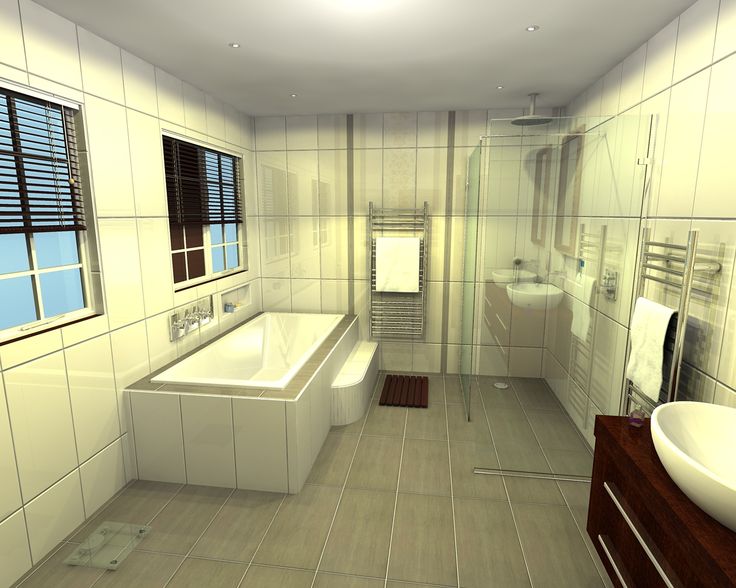 '
'
(Image credit: Darren Chung)
As wet room ideas don't have to have fixed shower enclosure sizes, you can use this as an opportunity to install a double shower set-up. Do you need or will you use two showers in the same space? Only you can answer that, but for a luxury bathroom idea, they can't be beaten.
This bathroom design, which includes a BC Designs bathtub, incorporates a micro cement shower floor running throughout the wet room, adding an industrial contrast to the marble and luxury fittings used.
10. Create an enclosure for a partial wet room
(Image credit: Matthew Williams)
To get the best of both worlds of a wet room, it's possible to divide your bathroom into wet and dry zones. This is usually done by combining the bath and shower into a wet room set-up, separated by an enclosure, but properly tanked in the way a wet room should be.
This leaves your basin and WC out of the wet zone, making it easier to use these spaces after someone has showered without entering into a wet, humid space.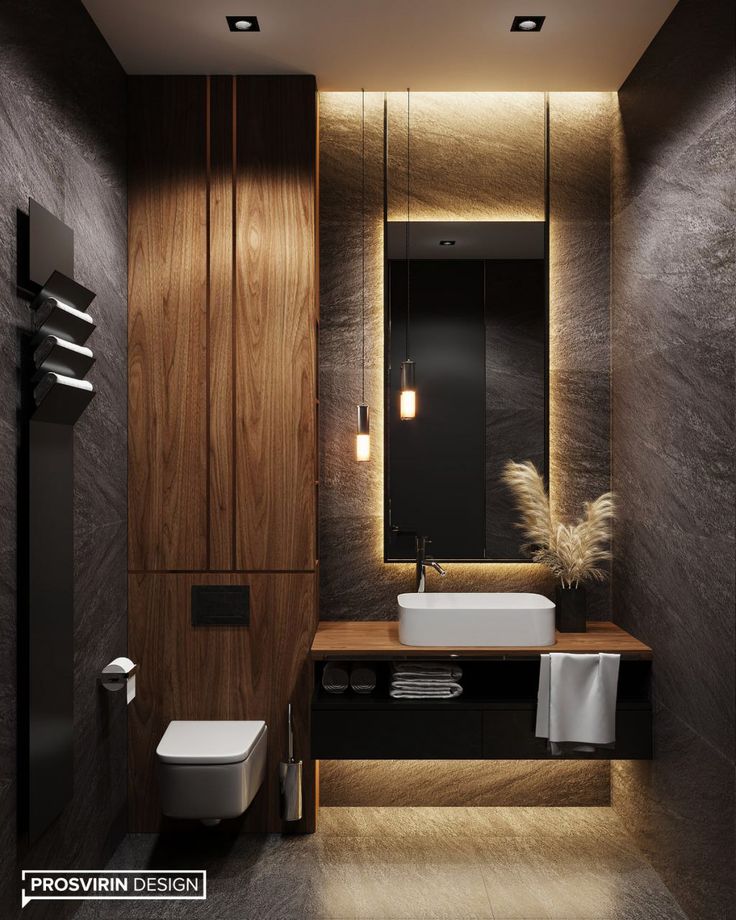
11. Create a broken-plan wet room
(Image credit: McCrum Studio)
This wet room set-up by interior designer Katie McCrum of McCrum Studio is another way you could look to divide up a bathroom for a more contained wet zone. This broken-plan enclosure means that the wall intersecting the bathroom could be used for this clever bathroom mirror idea, freeing up space in the bathroom, while the showers and bath sit beyond in a dedicated wet zone.
(Image credit: Anna Stathaki c/o BC Designs/C.P. Hart)
Wet rooms are well-loved for their walk-in shower designs, but how about a walk-through shower? In a design such as this, from C.P. Hart, a walk-through wet room set-up allows for an unusual freestanding bath idea, laid out with the tub in the center of the room, meaning the shower can be used from either side without disturbing the flow of the room.
While walk-through showers may take up extra space for both an entry and exit to the showering area, they have a luxurious feel about them that makes them well-suited to high-end bathrooms.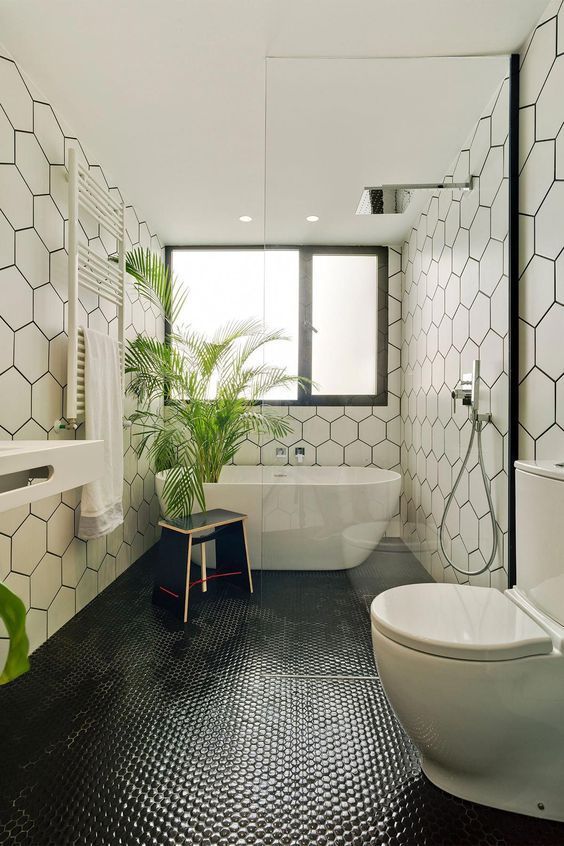
13. Try this clever idea to protect wet room windows
(Image credit: West One Bathrooms)
While this wet room from West One Bathrooms might be small, it's perfectly formed. Not only does this Crittall-style shower screen and hexagonal tile create a modern look, but the designers have come up with a clever way to be able to position the shower next to the window, without exposing it to water spray and excess moisture.
A hinged screen over the window not only protects it from the shower, but provides privacy when using the shower without sacrificing natural light. Plus, it can still be opened, like a traditional window treatment to enjoy the view.
What do you need to have a wet room?
To create a wet room, you'll need to create a watertight environment, for example by tanking both the floor and walls of the room to protect it from any leaks. Once a watertight membrane is laid, the room can then be tiled.
When deciding which wet room system to go for, think about what your sub-floor is made of.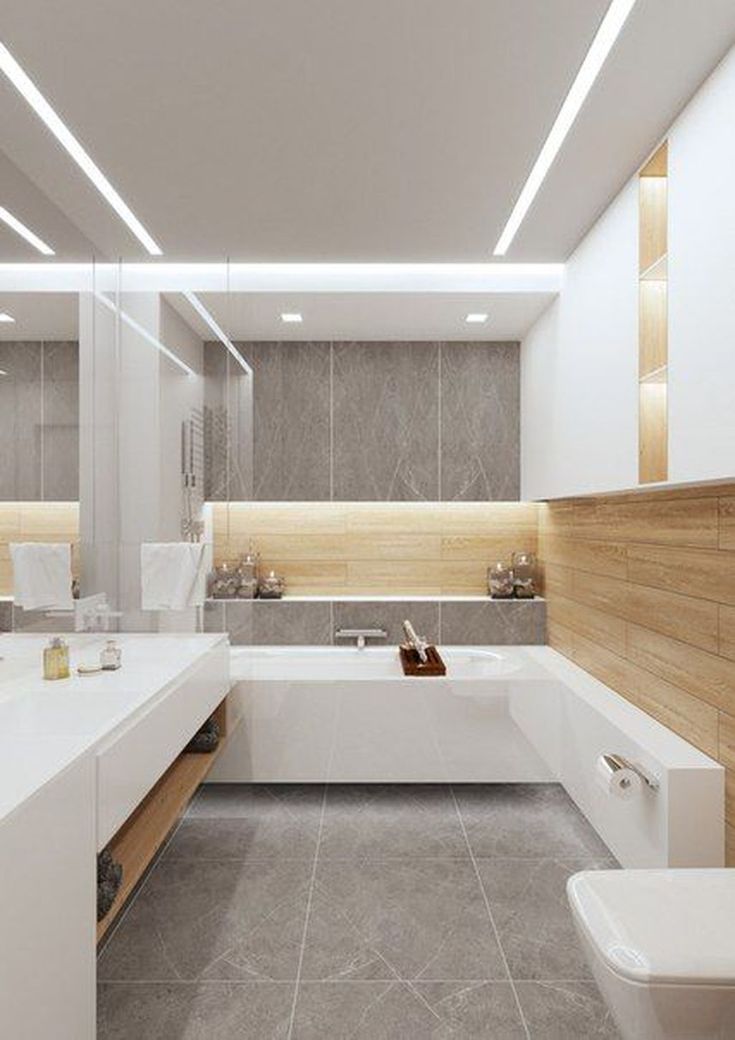 There are systems for both solid and wooden floors. If you have a concrete floor, it can be quite invasive to channel in a waste and create the gradient fall required for drainage.
There are systems for both solid and wooden floors. If you have a concrete floor, it can be quite invasive to channel in a waste and create the gradient fall required for drainage.
Forgoing a shower tray in favor of a wet room allows the floor tiles to run through to the shower area, which adds visual space to a room. However, not all surfaces are safe to use in a wet room setting and it is crucial to know what the slip rating of the material is. C.P Hart's Rebecca Milnes recommends using a material with a structured, textured finish to give extra grip in wet areas.
Tanking is also essential in a wet room. This is a multi-step process that entails several layers of waterproofing to ensure an excellent seal – much like a swimming pool. The two main approaches for tanking a wet room are using a self-adhesive bitumen-based waterproof membrane or applying a paint-on liquid wall membrane. It is always best to speak to your supplier about the best system for your project.
Hugh is the Deputy Editor of Livingetc.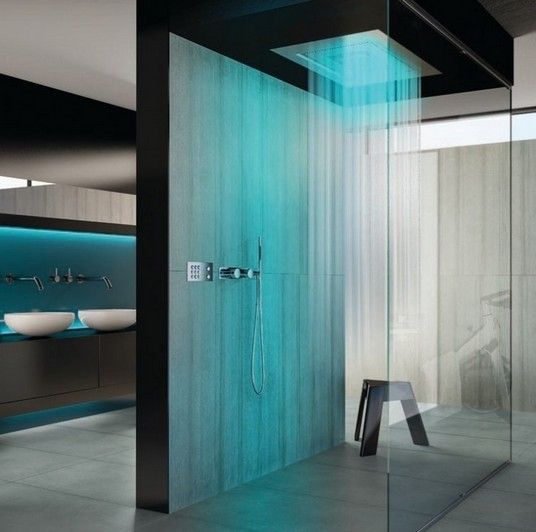 com. From working on a number of home, design and property publications and websites, including Grand Designs, ICON and specialist kitchen and bathroom magazines, Hugh has developed a passion for modern architecture, impactful interiors and green homes. Whether moonlighting as an interior decorator for private clients or renovating the Victorian terrace in Essex where he lives (DIYing as much of the work as possible), you’ll find that Hugh has an overarching fondness for luxurious minimalism, abstract shapes and all things beige. He’s just finished a kitchen and garden renovation, and has eyes set on a bathroom makeover for 2022.
com. From working on a number of home, design and property publications and websites, including Grand Designs, ICON and specialist kitchen and bathroom magazines, Hugh has developed a passion for modern architecture, impactful interiors and green homes. Whether moonlighting as an interior decorator for private clients or renovating the Victorian terrace in Essex where he lives (DIYing as much of the work as possible), you’ll find that Hugh has an overarching fondness for luxurious minimalism, abstract shapes and all things beige. He’s just finished a kitchen and garden renovation, and has eyes set on a bathroom makeover for 2022.
10 ideas for decorating a bathroom
Tips
Angle of view
Designer Dima Loginov: “This bathroom is an example of how, with a minimal budget, using just one graphic technique, you can create a complex interior that catches the eye . Thanks to an unusual splash of color on the floor and wall, the initially simple bathroom has gained depth (as the Americans like to say, “layers”). Tile manufacturers have a lot of developments that will help realize the most daring bathroom design ideas. Of the new technologies, digital printing is interesting, which allows you to imitate any natural textures with the highest accuracy and resolution. This, for example, makes it possible to use wood-grained porcelain stoneware." nine0003
Tile manufacturers have a lot of developments that will help realize the most daring bathroom design ideas. Of the new technologies, digital printing is interesting, which allows you to imitate any natural textures with the highest accuracy and resolution. This, for example, makes it possible to use wood-grained porcelain stoneware." nine0003
Perfect couple
Decorator Tatyana Alenina: “Marble and natural wood always complement each other perfectly in the interior. Plus, it's a trendy combination. The bathroom (pictured above) is fully in line with today's trends. The solid oak in the area where the sinks are located adds a honey hue to the cold gray tones of the room. There is no feeling of sterility here, which many projects sin, where bathrooms are finished only with marble. Regarding the practicality of this bathroom design idea: if there is a fear of ruining the wood, put a teak on the floor - it is not afraid of water, it can be beautifully tinted. ” nine0003
” nine0003
Screen test
Designer Colin Radcliffe: “I did a Hollywood bathroom in Notting Hill. This explains the palette and choice of finishing materials. The bath bowl is finished with black marble with artistic veins. The shower room is covered with tinted glass. The metal frames in which the glasses are installed are gilded. The chair is upholstered in soft white leather. Glass accessories look beautiful in such an environment.”
Nothing superfluous
Decorator Madina Vykhodtseva: “This project reflects the style of minimalism typical of Japanese interiors. The combination of "white moon color plus wood" looks very noble. The teak finish of the tub frame and floor is ideal for wet rooms. By the way, unlike the stone floor, as in this photo, it would be more pleasant to walk barefoot on a wooden floor. Wood, stone and water - a combination that helps to feel in touch with nature. This effect is enhanced by a window through which the sun enters the room.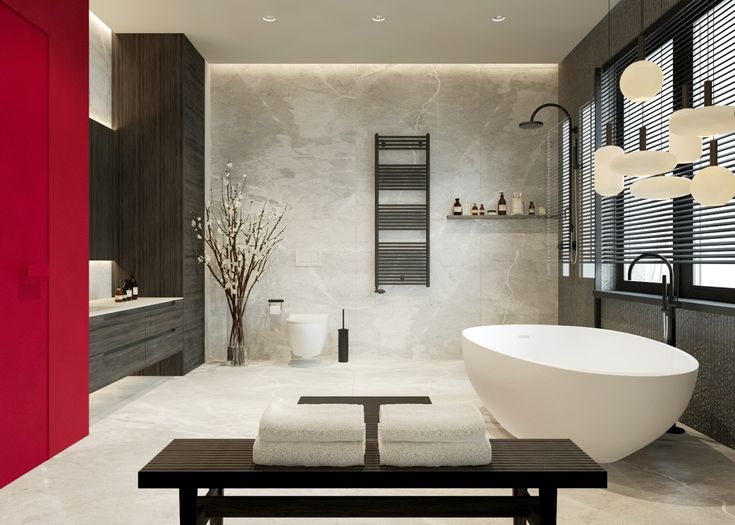
Lessons from history
Designer Mike Shilov: “The bathroom, designed by decorator Jacques Garcia, is decorated in the spirit of palace boudoirs. I love this bathroom design idea. A bold color scheme brings a certain energy to this realm of bliss and peace. The combination of shades of curtains, carpet, marble is perfectly matched. The coincidence of the pattern on the wallpaper and the fabric undoubtedly adds integrity to the composition. Cement tiles with a noble patina are the perfect backdrop for a luxurious white bathtub. It is in the balance of valuable and simple materials, simple and complex, that I see the beauty and sophistication of this interior.” nine0003
Keep the proportions
Decorator Alexander Kozlov: “It is difficult and at the same time interesting to work with irregularly shaped rooms. Custom bathroom design ideas needed. Just for such cases, a small mosaic on the floor is a great idea. The arched shape of the window is emphasized by a mirror of the same shape.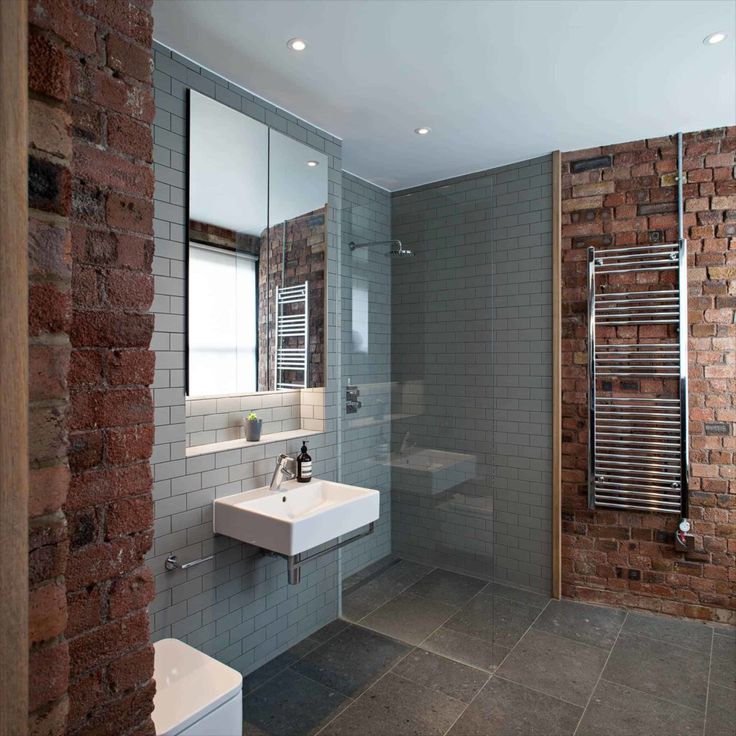 As you can see, one axis of symmetry is enough to make the room look correct and comfortable. Special thanks for the sculptures and antiques (chandelier) - it always gives the interior a special chic. nine0003
As you can see, one axis of symmetry is enough to make the room look correct and comfortable. Special thanks for the sculptures and antiques (chandelier) - it always gives the interior a special chic. nine0003
Monochrome
Designers Taras Bezrukov and Stas Samkovich: “Very “architectural” and laconic interior. Black and white is always relevant. By changing decor items, you can create different moods. The style-forming element of this composition is a non-standard sink finished with microcement. We love the window trim with round holes, which serves as both a sun shield and a decorative element. This idea can also be used in a bathroom without a window by installing artificial lighting in the installation.” nine0003
Golden thread
Decorator Anna Muravina: “I like this bathroom. It has a personality that is a real luxury. Very beautiful combination of stone and mosaic. I can appreciate the busyness of this interior. In one of our projects, we also laid out "seams" of smalt on the stone floor.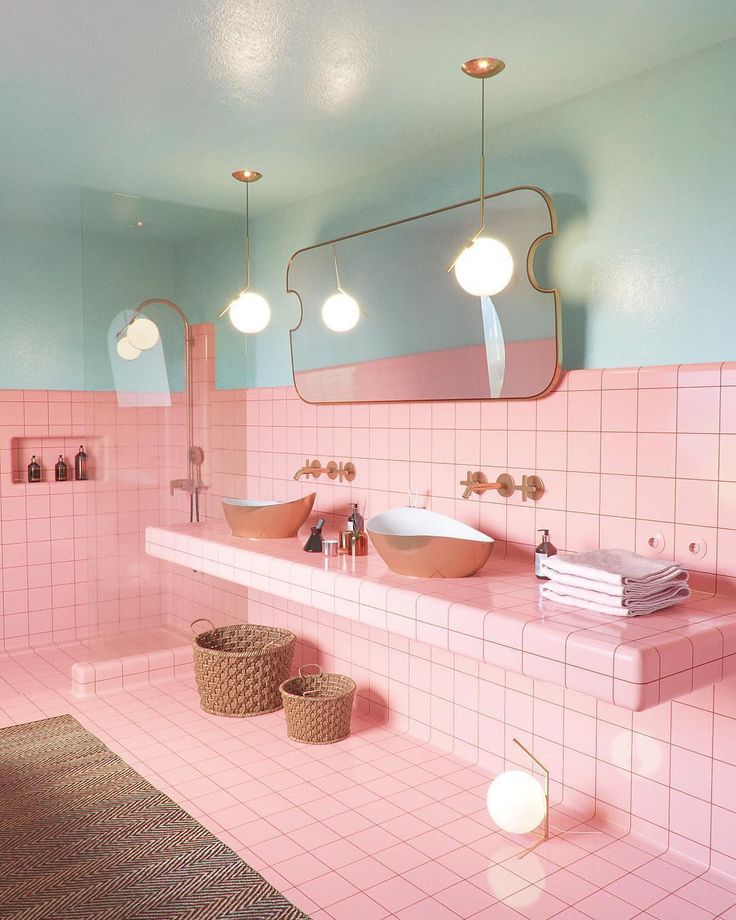 Technically, it turned out to be very difficult. White oriental sconces are a little embarrassing. They fall out of the general picture of the interior, designed in the spirit of Art Deco. I would take the gray color of the walls more densely (approximately in the tone of the mosaic). On it, the pattern of the stone would have looked more spectacular. nine0003
Technically, it turned out to be very difficult. White oriental sconces are a little embarrassing. They fall out of the general picture of the interior, designed in the spirit of Art Deco. I would take the gray color of the walls more densely (approximately in the tone of the mosaic). On it, the pattern of the stone would have looked more spectacular. nine0003
Retro style
Designer Nadya Zotova: “Small floor tiles, glass partition — all this is appropriate in a hotel, but not in a residential building. Captivating bold colors. In combination with chrome accessories, it creates a retro mood. I would enhance this technique by adding a chandelier with glass pendants and replacing a boring mirror with a shelf with an analogue in a complex frame. By the way, it is better to place the backlight not above the mirror, but on the sides, then the face will be lit evenly. nine0003
Mirror surface
Decorator Marina Filippova: “Lightness, cleanliness and light – this interior contains all the components of an ideal bathroom.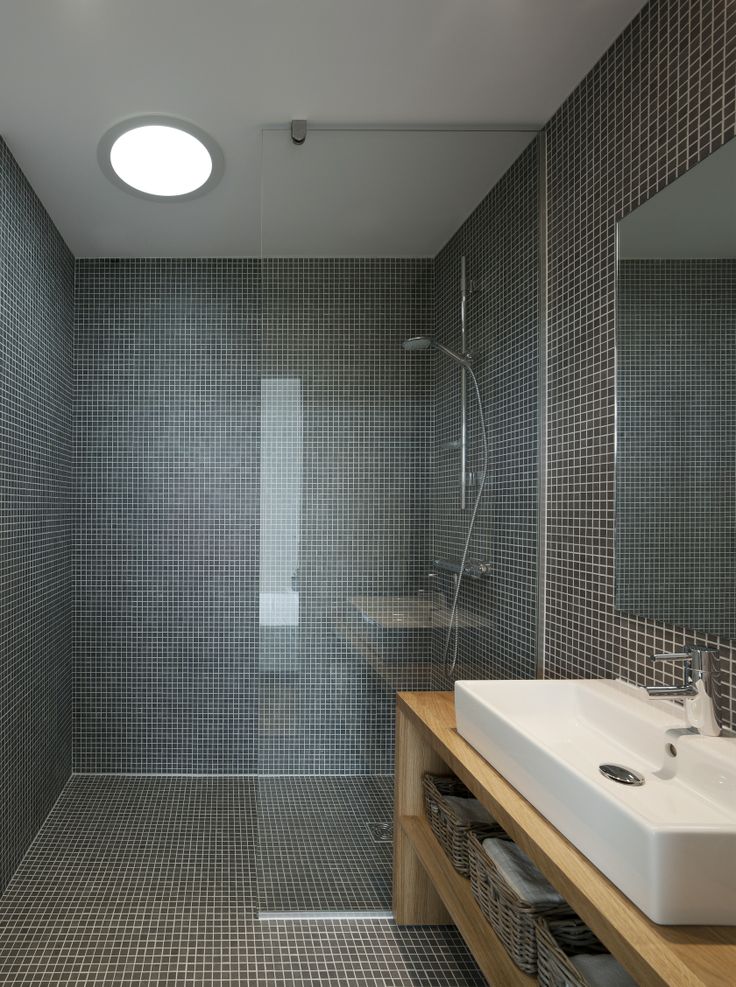 Despite the monochrome white, there is no sense of sterility here. The collection of table mirrors and pendants in the form of glass balls add sophistication to the interior. Mirrored cabinets hide many of the little things that usually clutter up a bathroom interior. Each drawer has a cleverly disguised handle, so the mirrors stay perfectly clean.” nine0003
Despite the monochrome white, there is no sense of sterility here. The collection of table mirrors and pendants in the form of glass balls add sophistication to the interior. Mirrored cabinets hide many of the little things that usually clutter up a bathroom interior. Each drawer has a cleverly disguised handle, so the mirrors stay perfectly clean.” nine0003
Tags
- Bathroom
6 styles and 6 design ideas
The bathroom is perhaps one of the most intimate and intimate spaces in the house. As a rule, this is a small space in which space is allocated for both domestic needs and relaxing procedures. At the same time, your guests will also visit the bathroom if they do not have a separate guest bathroom. All these factors already indicate that competent planning and harmonious design of the bathroom is not an easy task. But in this article, we will be happy to help you. Let's look at the current trends and bathroom design ideas for future seasons.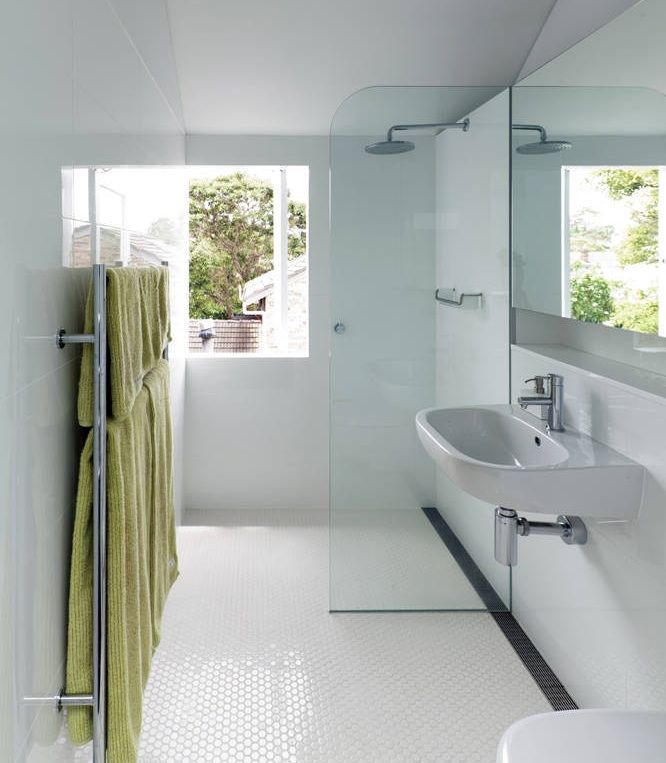 nine0003
nine0003
Bathroom Design Trends
If you are planning a renovation in the near future, but still have not decided what you want to see in the design, we recommend that you familiarize yourself with the bathroom design trends 2021-2022. So, here's what experts in the interior industry advise you to pay attention to:
1. Eco minimalism
For several seasons, minimalism and eco have been sharing the leading positions in interior styles. And it is absolutely not surprising that their mixture - Japanese minimalism is still relevant today. The atmosphere of naturalness and relaxation, a kind of zen, the use of marble, natural wood are harmoniously combined with laconic modern plumbing, lighting, washing and drying equipment. nine0003
2. Atmosphere SPA
The bathroom is a place of relaxation. Scented candles, relaxing music, subdued light will help to relax, harmonize your body and thoughts. Functionality in this case fades into the background, giving way to comfort and relaxation.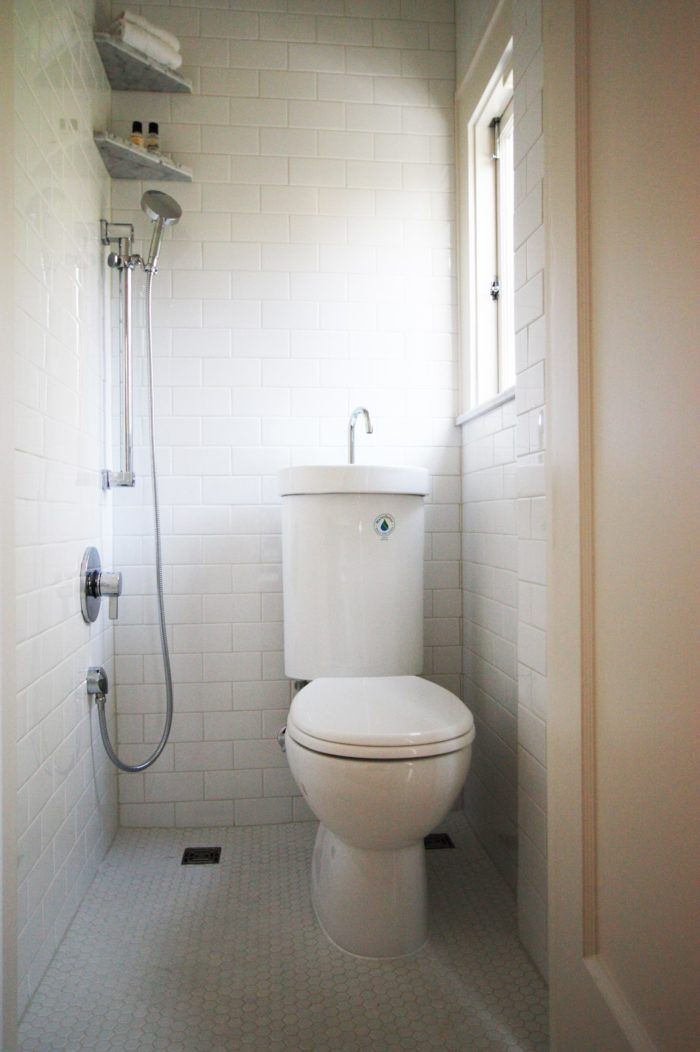 Artificial grass mats, pebble paths, showers with hydromassage modes will complement your personal home SPA well.
Artificial grass mats, pebble paths, showers with hydromassage modes will complement your personal home SPA well.
3. Suspended sanitary ware
Tired of dusty corners and smudges? Do you want to free up the floor as much as possible and make cleaning easier? Suspended plumbing will be the perfect solution for you. Today, the plumbing market is very rich in such modern options. You can hang absolutely everything: sink and cabinet, toilet and bidet. Just imagine how stylish and unusual a bathroom floating in the air will look. And if all this is supplemented with interesting lighting? Thanks to this technique, you will not only free up floor space, but also visually increase the volume of the room, which is very important for small rooms. nine0003
4. White marble combined with gold
Luxurious noble white marble and elements of gold – isn't this the bathroom of kings? References to the Art Deco style will be very relevant in combination with mirror surfaces.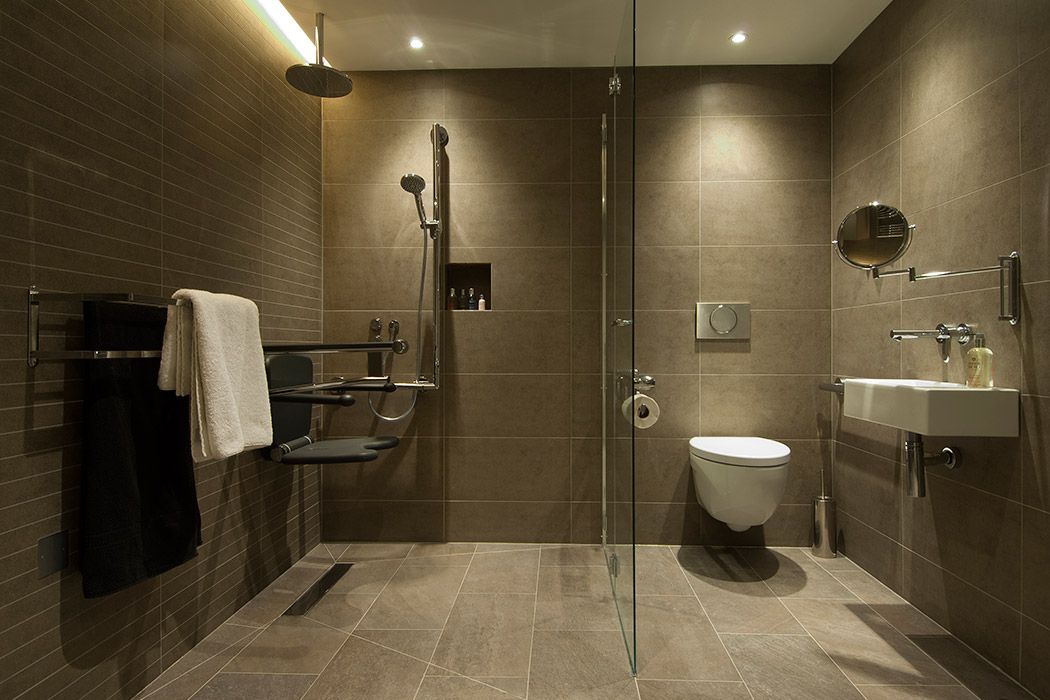
5. Interesting lighting
A sophisticated bathroom lighting system is something to strive for. On the one hand, you will need bright light to perform all cosmetic and water procedures, on the other hand, to create a relaxed atmosphere, it is better to dim the bright light and create a slight twilight. Illuminated mirror, spot lighting, LED strips - use everything at once. nine0003
6. Natural color scheme
Given all the previous topical solutions, this trend has become a regularity. In future seasons, light shades will dominate in bathroom interiors - beige, gray, cream, coffee with milk. Actual colors of natural wood and stone. Bright colors are only suitable for accents.
How to choose a bathroom style
When planning a bathroom renovation, you will definitely come across a choice of stylistic solutions. What should you pay attention to? First of all, on the dimensions of the room.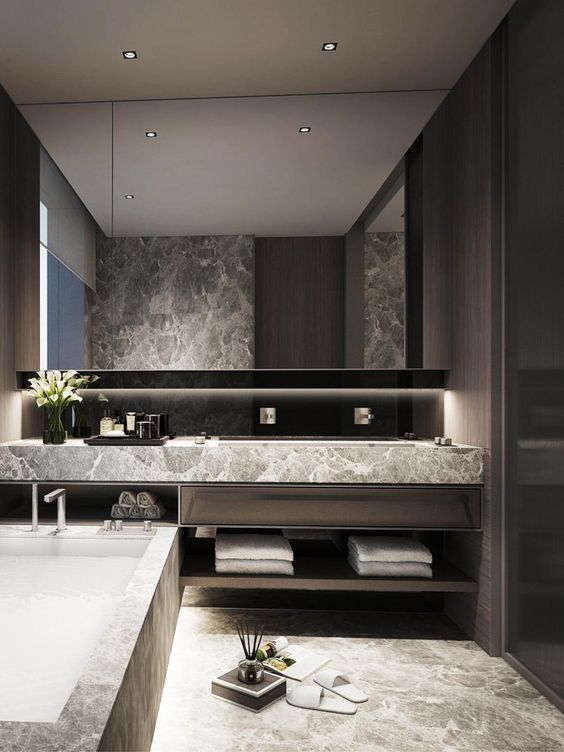 If your bathroom is small enough, then it is better to give preference to the styles of minimalism, Provence, hi-tech, scandi. For spacious rooms, art deco, classic, loft would be quite appropriate. Let's find out which bathroom styles will be relevant in 2022.
If your bathroom is small enough, then it is better to give preference to the styles of minimalism, Provence, hi-tech, scandi. For spacious rooms, art deco, classic, loft would be quite appropriate. Let's find out which bathroom styles will be relevant in 2022.
1. Art Deco
Modern Art Deco bathroom is a luxurious combination of black and white marble, unusual oriental patterns and gilded fittings. In such a bathroom there will definitely be a place for a “fluffy” rug with a large pile or imitation of an animal skin, large mirrors and numerous light sources. Absolutely vulgar glamor with a sense of proportion and a hint of nobility. nine0003
2. Pompous classic
Luxurious classic is another trendy option for modernizing the bathroom. Even today, in the 21st century, the palace atmosphere of the Renaissance is revered by most interior professionals and lovers of beauty. A noble stone in the finish, a free-standing bathroom on carved figured legs, rare cabinets and massive chests of drawers, bas-reliefs and arches, mirrors and gold.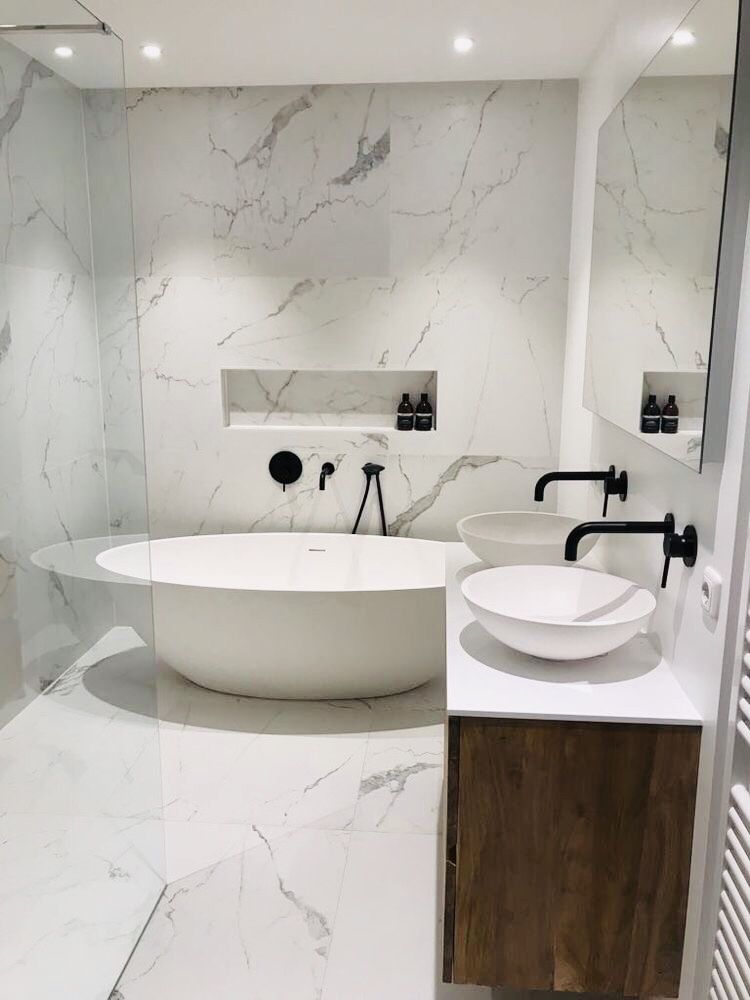 A classic-style bathroom will take you to romantic Venice. A real find and highlight in such a space will be a photo tile depicting European castles, classical patterns and masterpieces of world art. nine0003
A classic-style bathroom will take you to romantic Venice. A real find and highlight in such a space will be a photo tile depicting European castles, classical patterns and masterpieces of world art. nine0003
3. Neoclassic
All the best from the classics in a new interpretation. Stylized aged faucets of elegant shape, all the same free-standing bathtubs. A neoclassical bathroom is bohemian chic combined with boldness and modern technology. It is worth noting that this style is suitable for bathrooms with a fairly free layout and a fairly large area. If your layout includes a small bathroom with a separate toilet, we recommend demolishing the wall, thereby increasing the area. nine0003
4. Loft
A bold and extremely popular solution is the design of the bathroom and the bathroom in the loft style. This space looks very modern and stylish. In addition, a loft-style bathroom and toilet do not need a large number of square meters.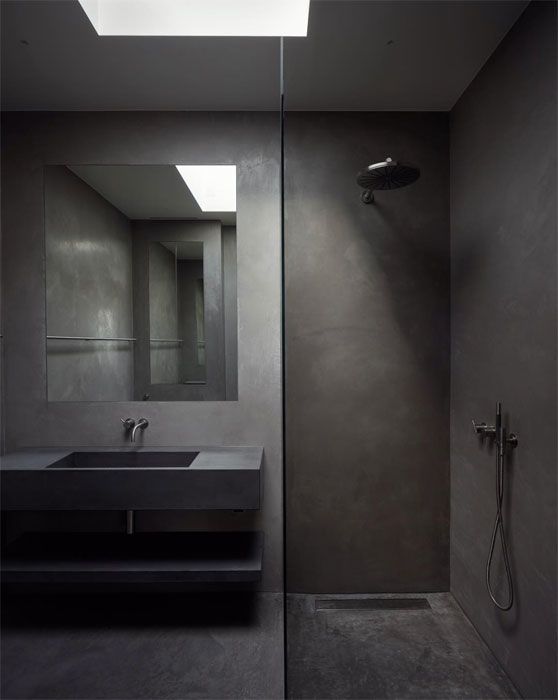 Even with a standard modest layout, you will have where to turn around in interior creativity. Brickwork, a concrete wall or their beautiful imitation, wooden beams and deliberately rough plumbing elements that are not hidden behind boxes and false panels, but rather are one of the main design elements. Industrial style every season finds more and more adherents and admirers. nine0003
Even with a standard modest layout, you will have where to turn around in interior creativity. Brickwork, a concrete wall or their beautiful imitation, wooden beams and deliberately rough plumbing elements that are not hidden behind boxes and false panels, but rather are one of the main design elements. Industrial style every season finds more and more adherents and admirers. nine0003
5. Eco style
As we have already mentioned, one of the most popular trends in bathroom design is the creation of a home SPA atmosphere. Naturalness, naturalness and simplicity. An eco-style bathroom is comfort and nothing superfluous, just like in nature itself. The decoration is dominated by natural materials and their imitation - wood, stone. Much attention should be paid to the textures of these materials, it should be pronounced. A minimum of decor and unnecessary elements. In an eco-style bathroom, you can often find artificial or natural greenery - creepers, bamboo, moss.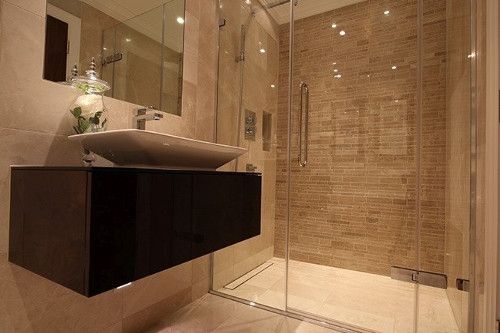 The color scheme is as natural as possible - sand, gray, wood, white and black. nine0003
The color scheme is as natural as possible - sand, gray, wood, white and black. nine0003
6. Minimalism
Minimalism in the bathroom interior is conciseness and practicality. Elegant clear lines and geometric shapes of surfaces (sinks, bathtubs, showers, etc.). There are no unnecessary items, each of them performs its function. Cabinets and cabinets hide all the necessary little things, such as towels, powders, household chemicals - everything that you cannot do without in the bathroom and the bathroom. Minimalism in the bathroom is tile, wood and glass. The color scheme is predominantly cold, because it is these shades that add volume and airiness to the space. nine0003
Have you decided on a style? Let's move on to color!
Color of the bathroom and toilet
The choice of a color solution for the bathroom is perhaps one of the most difficult moments on the way to the ideal interior. A lot depends on color - both visual perception and our psycho-emotional state in the room.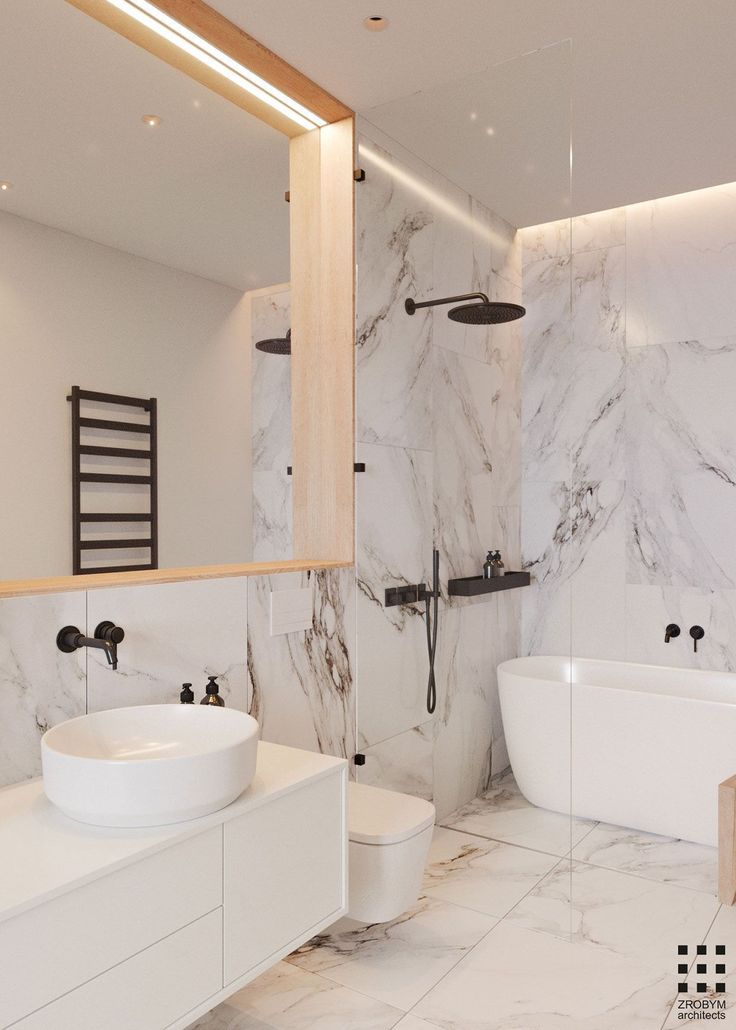 Thanks to the play of colors, you can visually increase or decrease the dimensions of the room. Let's talk about primary colors in more detail. nine0003
Thanks to the play of colors, you can visually increase or decrease the dimensions of the room. Let's talk about primary colors in more detail. nine0003
- White. This is a classic bathroom solution. In many ways, the popularity of this style lies in its ability to increase the volume of space and the feeling of cleanliness and, so to speak, sterility. White is synonymous with purity and freshness. So that you do not associate a white bathroom with a hospital ward, we recommend adding warmer colors to the design - cream, pearl shades, sand and beige. Warm shades will soften the perception of space. White goes perfectly with black. Clear geometry, pronounced accents - these techniques will make the interior more modern and strict. By the way, this color can become the base for any of the current interior styles. nine0070
- Black. A bold yet stylish solution that is ideal for spacious bathrooms. Black color is first of all elegance. White, red elements will complement it and present it in the best light.
 Black goes well with metallic sheen - gold and silver.
Black goes well with metallic sheen - gold and silver. - Red. A color that creates a real energy explosion, which means that you need to be extremely careful with it. Red color is definitely contraindicated in small rooms. It is best to dilute it with white, gray and black elements. nine0070
- Orange. Color, variations of which can often be found in the design of the bathroom. Less saturated shades of orange, such as peach, are perceived harmoniously and softly. Especially if it is combined with white and cream.
- Green. The color of life. It is ideal for the bathroom, both as a base and as an accent. It calms and relaxes. Green elements in the bathroom are well combined with white, black, yellow and blue colors.
- Blue and blue. Depth and airiness - what is so necessary for such rooms as a bathroom. Blue shades of different saturation and intensity can be harmoniously combined with white, gray and silver, black, green colors. In combination with beige and gold, you need to be extremely careful.
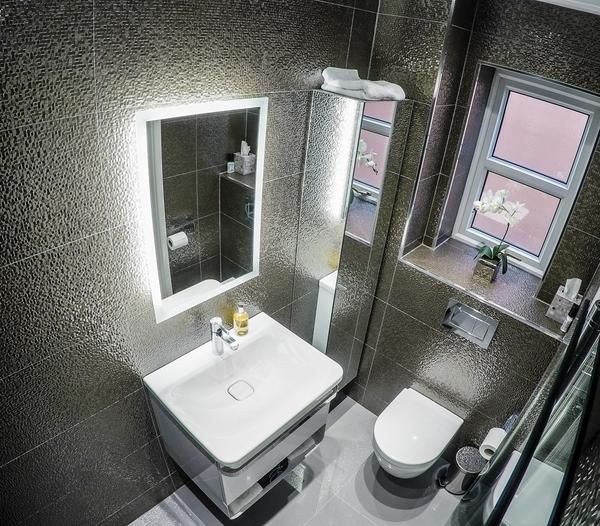 Remember the main rule: the smaller the area of \u200b\u200bthe room, the lighter the color should be. nine0070
Remember the main rule: the smaller the area of \u200b\u200bthe room, the lighter the color should be. nine0070 - Violet. A bold and yet unusual color in the design of the bathroom. Lilac shades give the space a certain mystery and romance. Purple is elegant and concise. The main thing is to use it in moderation.
We've talked about trends, styles and colors… What else should you keep in mind when planning your bathroom interior? Of course, about the materials.
Bathroom materials
The bathroom is a place that needs constant cleanliness and order. Given this, the materials used in the decoration and design of the premises should be as practical as possible, moisture resistant and wear resistant. This means that wallpaper is definitely not the material that is suitable for the bathroom. nine0003
A couple of years ago, plastic panels were a hit in bathroom design. They fell in love with their relatively low cost, ease of installation and the ability to decorate the space with unusual patterns.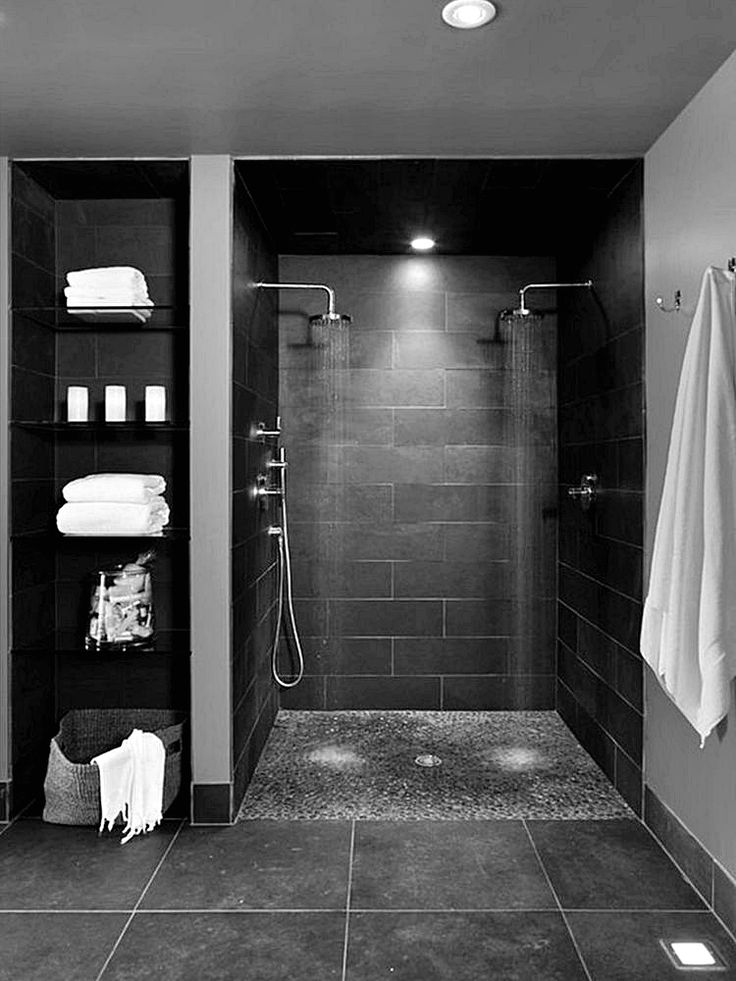 However, this material also has disadvantages - plastic is toxic and not particularly wear-resistant.
However, this material also has disadvantages - plastic is toxic and not particularly wear-resistant.
Favorites for wet rooms are ceramic tiles and porcelain stoneware. Ceramics is sufficiently resistant to external influences, it is resistant to damage and water. The ceramic tile market is very rich - manufacturers offer a variety of modifications and shapes - classic rectangles, squares, scales and rhombuses, polygons. Ceramic tiles in the design of a large format bathroom have become especially popular. An endless range of colors and shades, shapes and sizes allow you to create an unusual stylish interior. But what if you want something bigger and more special for your walls? nine0003
Exclusive solutions for bathrooms and bathrooms
There are many layouts of bathrooms, many times more finishing options. But what if you want to create an absolutely unique interior, unlike others? An interior that you will admire and be proud of. With the company "ORTOGRAPH" you have such an opportunity.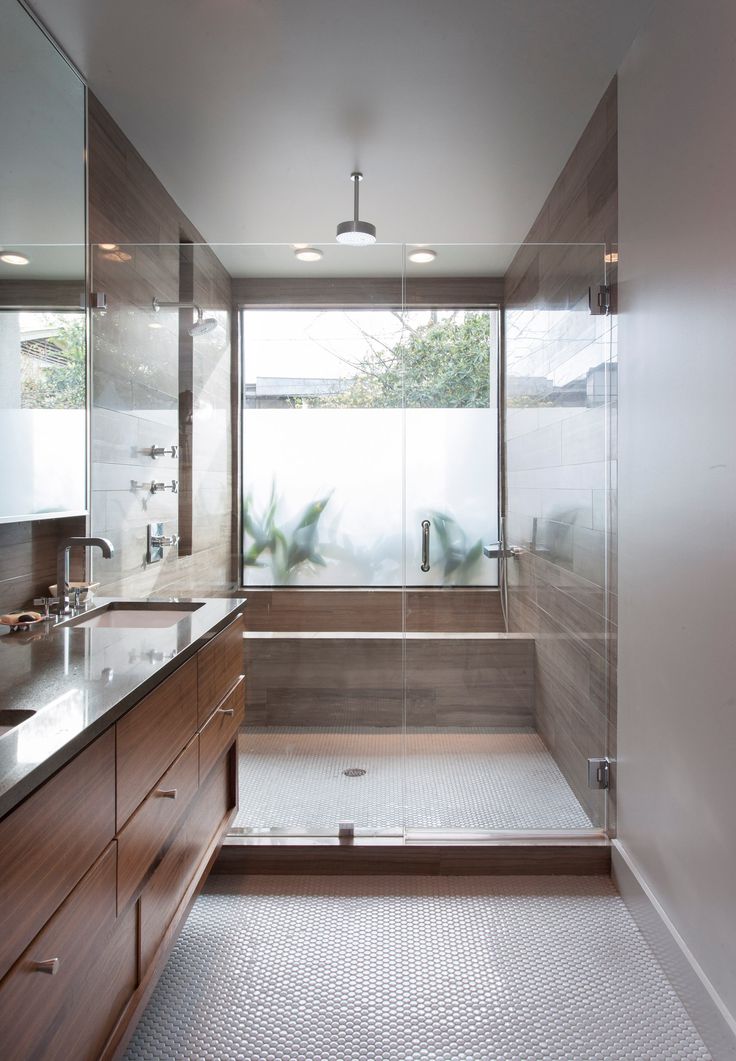
An original panel on ceramic tiles and porcelain stoneware with any image will make your interior unique. You can choose absolutely any plot and not be afraid that over time it will lose its beauty. Fabrizio Roberto photo tiles are not afraid of direct contact with water and exposure to household chemicals. The image is applied to the tile with UV ink and covered with a reinforced layer of protective varnish. This means that your favorite picture, whether it is a landscape of a tropical beach, a spectacular metal texture or a geometric abstraction, will delight you with its appearance and decorate the space for many years. nine0003
Fabrizio Roberto mosaic will look more elegant and unusual. Elegant glass chips add volume to the plot. The mosaic looks luxurious and noble. Its charm is also in the fact that not only flat straight surfaces can be decorated with mosaics. It is also suitable for concave / convex structures. Mosaic can be laid out not only on the walls, but also on the floor in the shower room, the sides of the jacuzzi or the bottom of the pool.





